[Review] Logitech G810 Orion Spectrum. Miracle of ergonomics
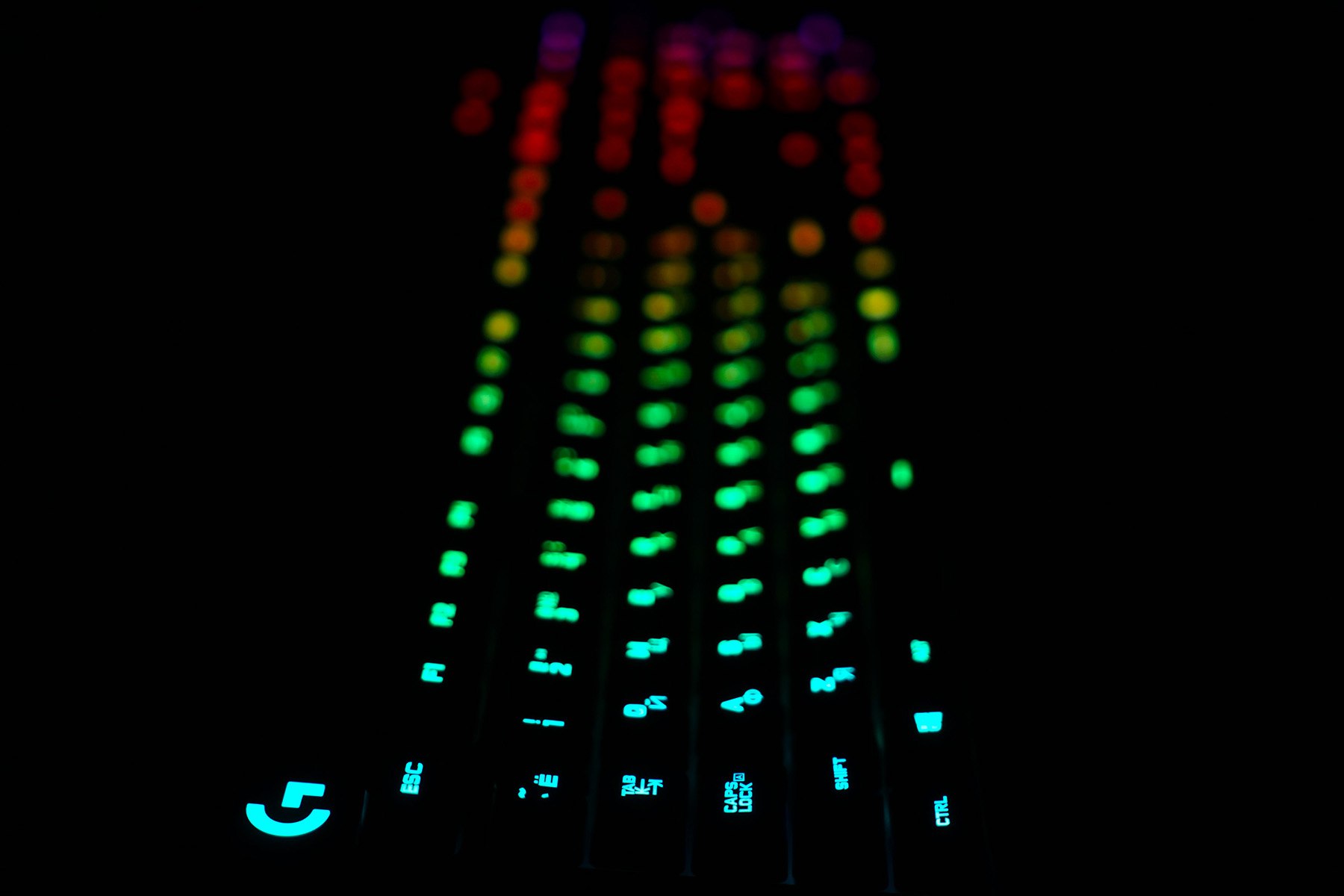
Perhaps Logitech is the only company that loves to experiment with literally everything. And with mice, and with keyboards, and with forms, and with a stuffing. Who else could risk putting unique and untested switches on a classic board by anyone and claim that this is the top solution for players? Only Logitech.
For a long time I looked at their keyboards with some degree of skepticism (why is there a mechanic on some unknown switches?), And when I took this keyboard in my hands, then I seriously changed the whole idea of what they are doing in Logitech.
And only in a positive way.
')
Box and equipment
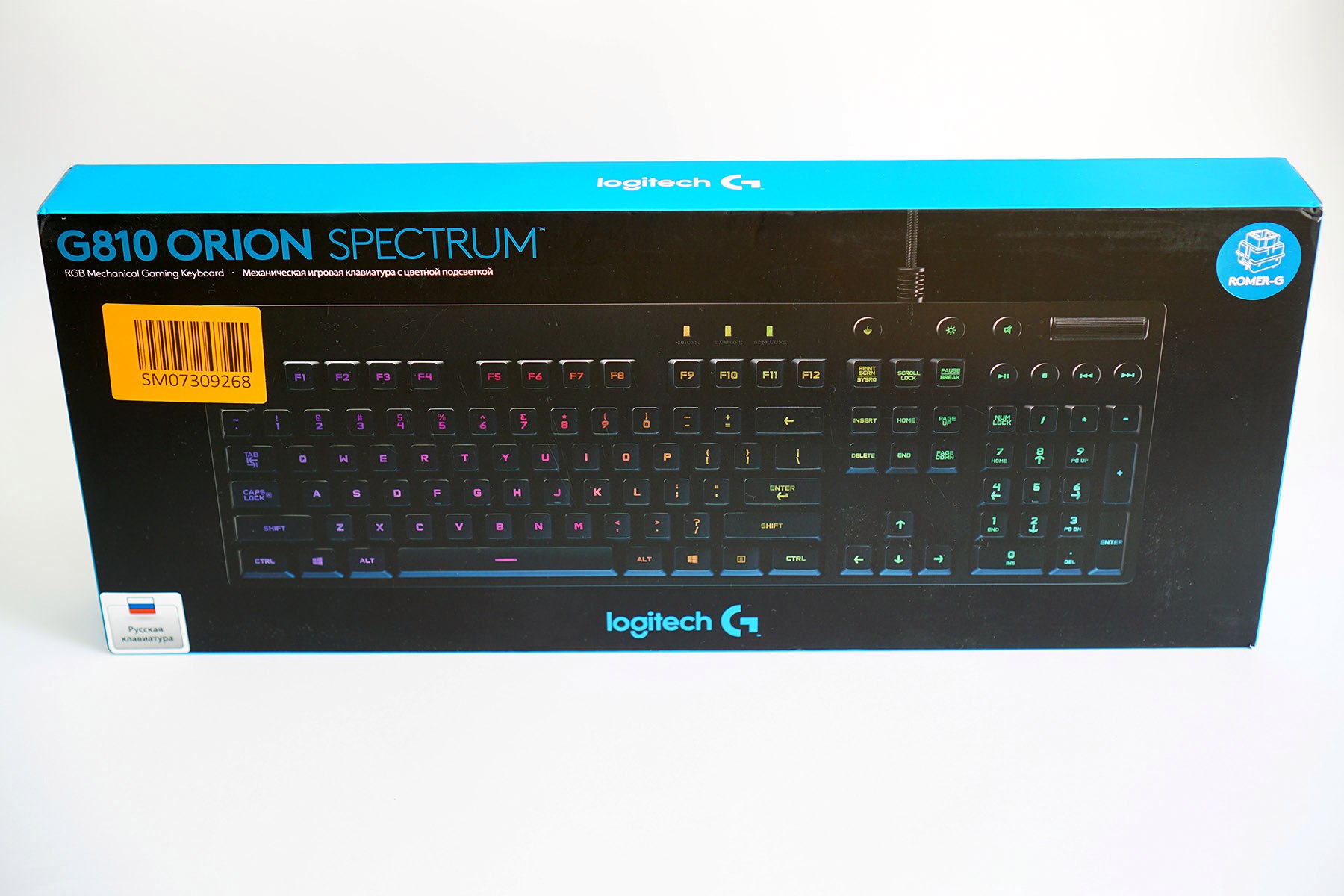
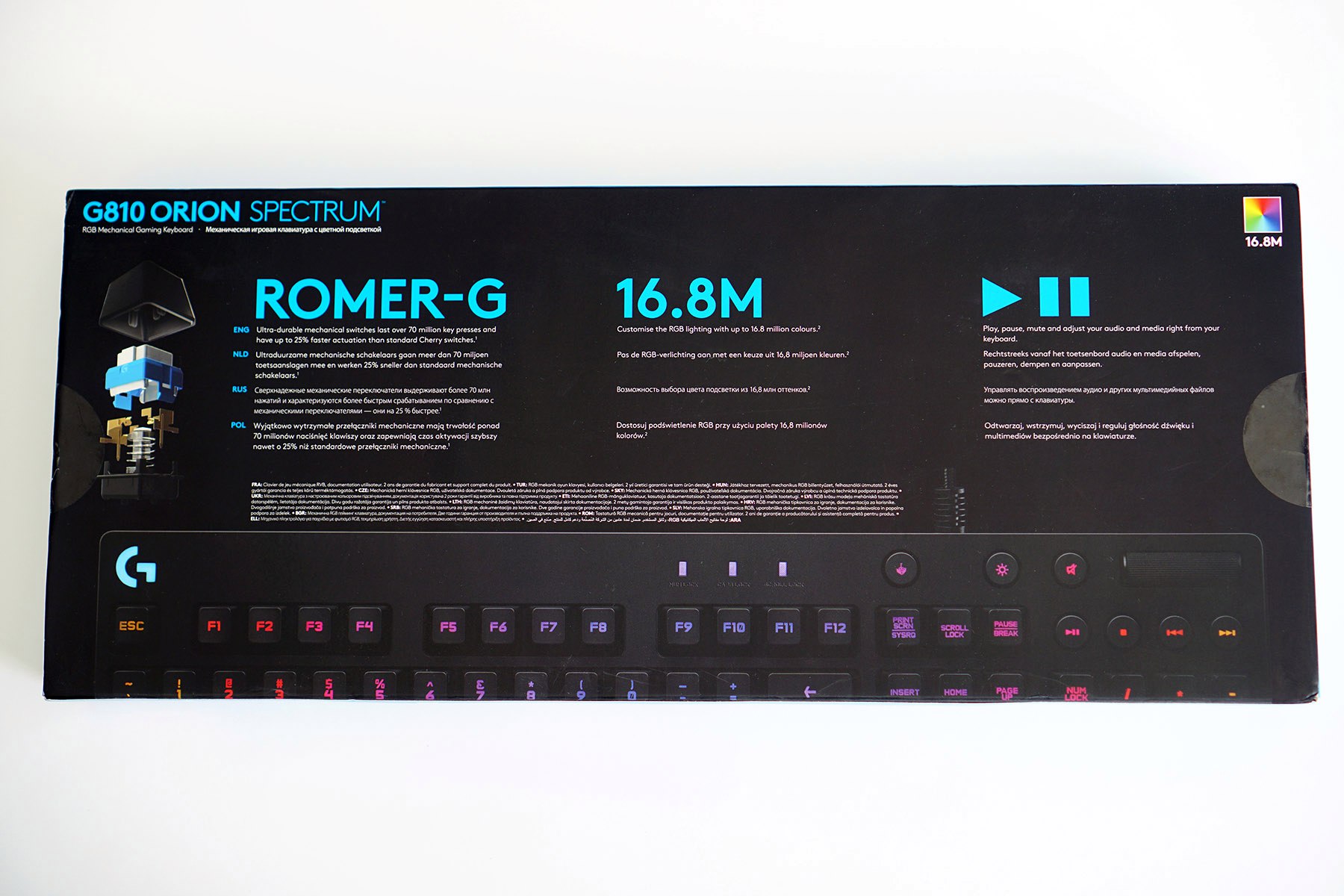
The keyboard is packaged in a simple black box of corrugated cardboard, on top of which is a cardboard sleeve. The sleeve is decorated simply, informatively, in black and blue corporate colors, talking about the game orientation of the device. The sleeve shows the keyboard, shows the type of switches and describes some of the chips.
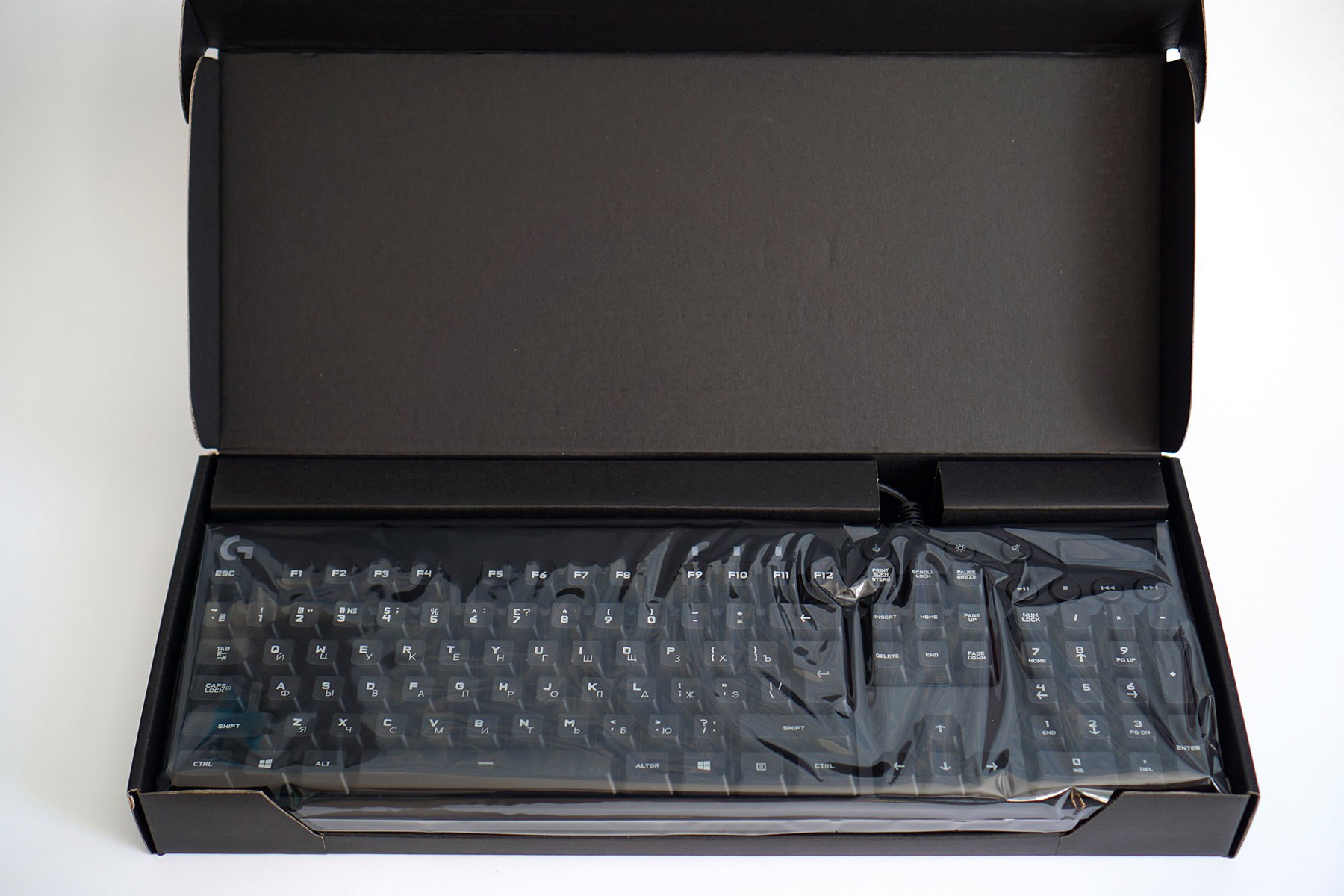
Inside the box is the keyboard in a crispy plastic bag, and under it is
Keyboard design and ergonomics
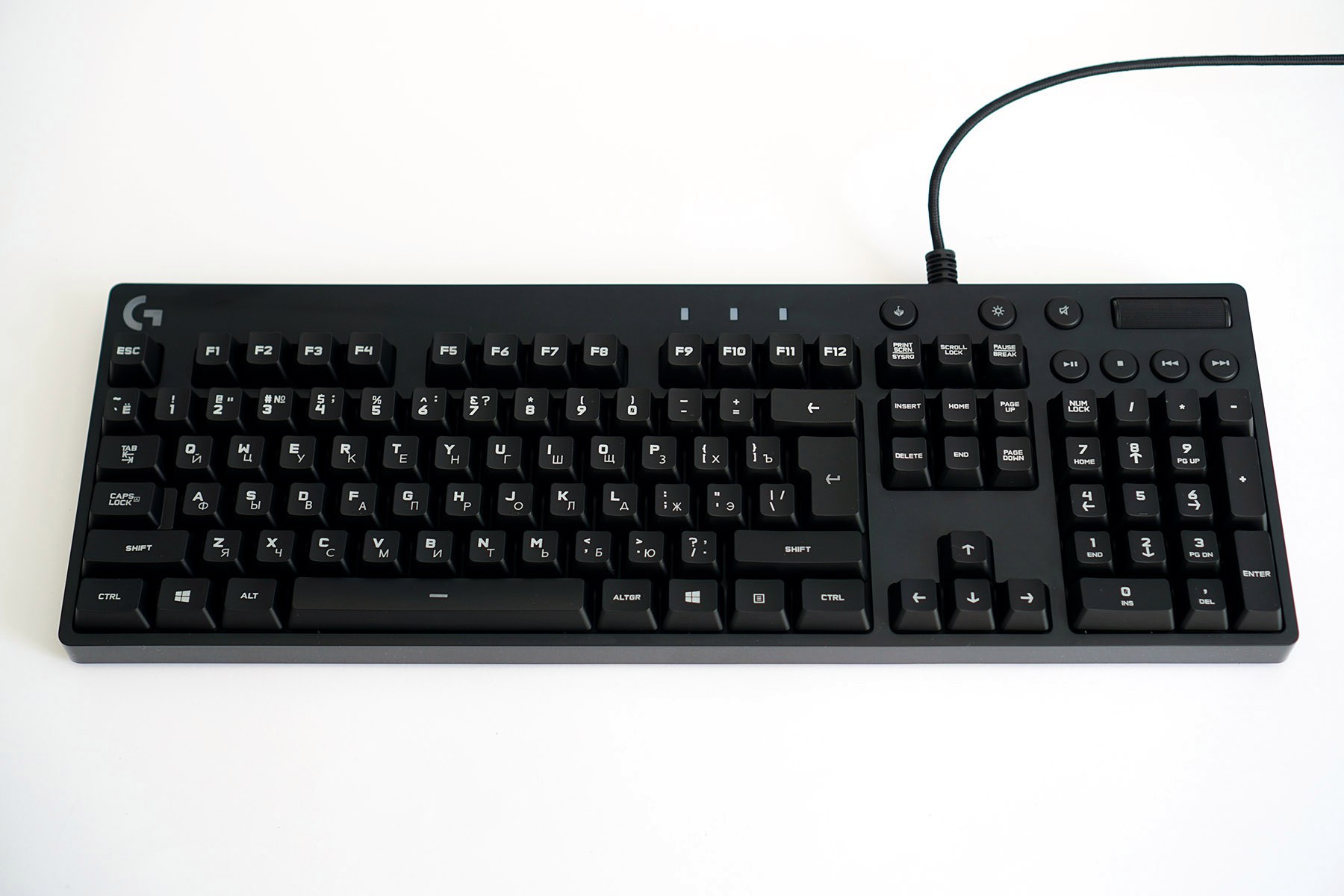
Logitech G810 - full-size mechanical keyboard with a block of additional keys and a volume control wheel. The main 104 keys are built on Romer-G switches; in addition, there are additional non-mechanical keys on the keyboard that are responsible for various functions, such as turning off the backlight or turning on the game mode.
The case is executed in the classic form factor, except that the upper part is slightly increased due to the presence of additional controls. The dimensions of the keyboard (in mm) are 443.5 x 153 x 34.3; Keyboard weight without cable - 1180 grams. The keyboard has a full RGB-illumination of all keys. Additional ports of connection (yusb, audio) are absent.
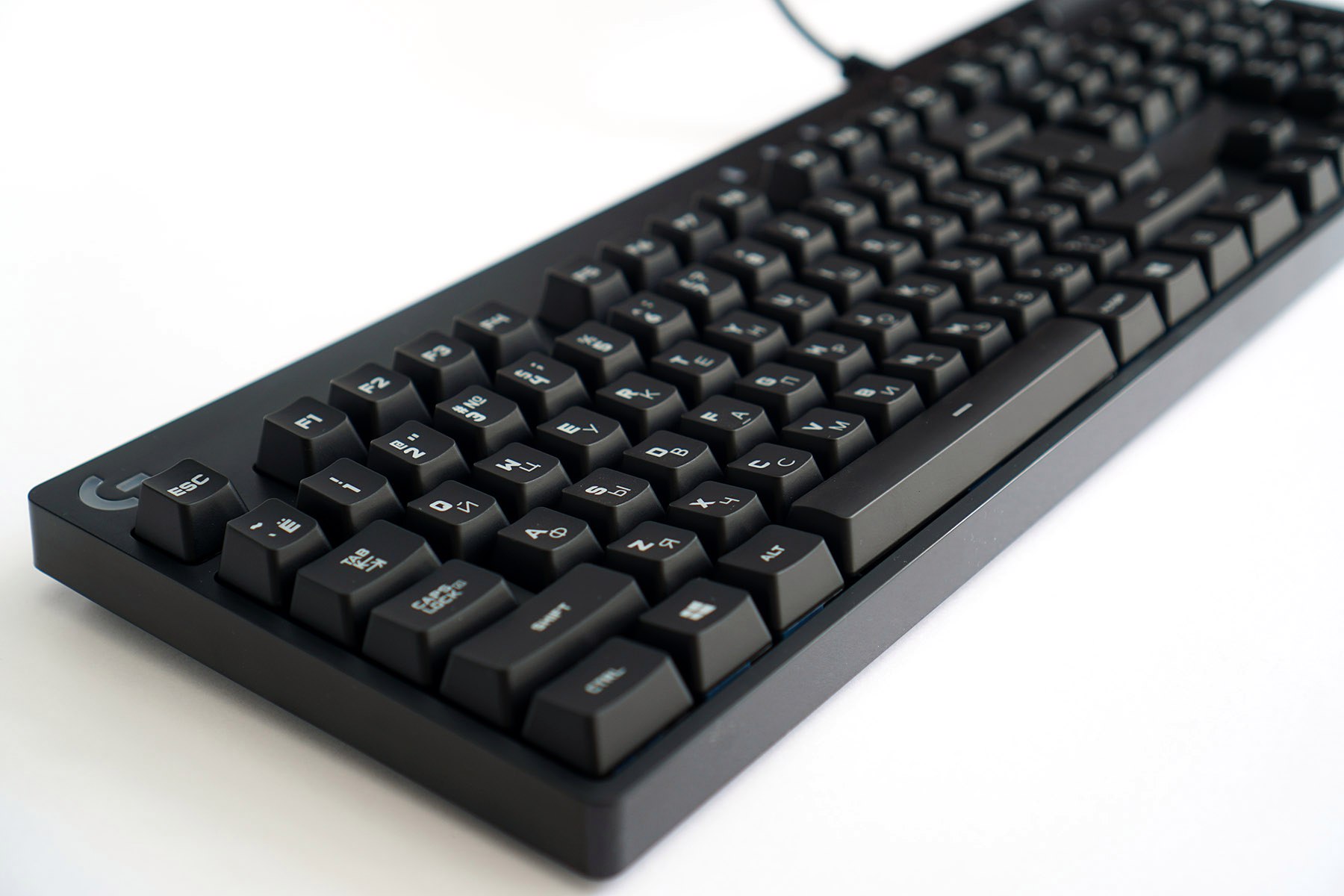
The keyboard looks stylish indecently - this is the first feeling that arises as soon as you take it in hand. Immediately it feels that this is not “another kind of keyboard that I have had”, but ... unusual or something. That is, it is quite a classic, but this magic effect is fully present. It just feels like it is different from many keyboards with a similar classic version.
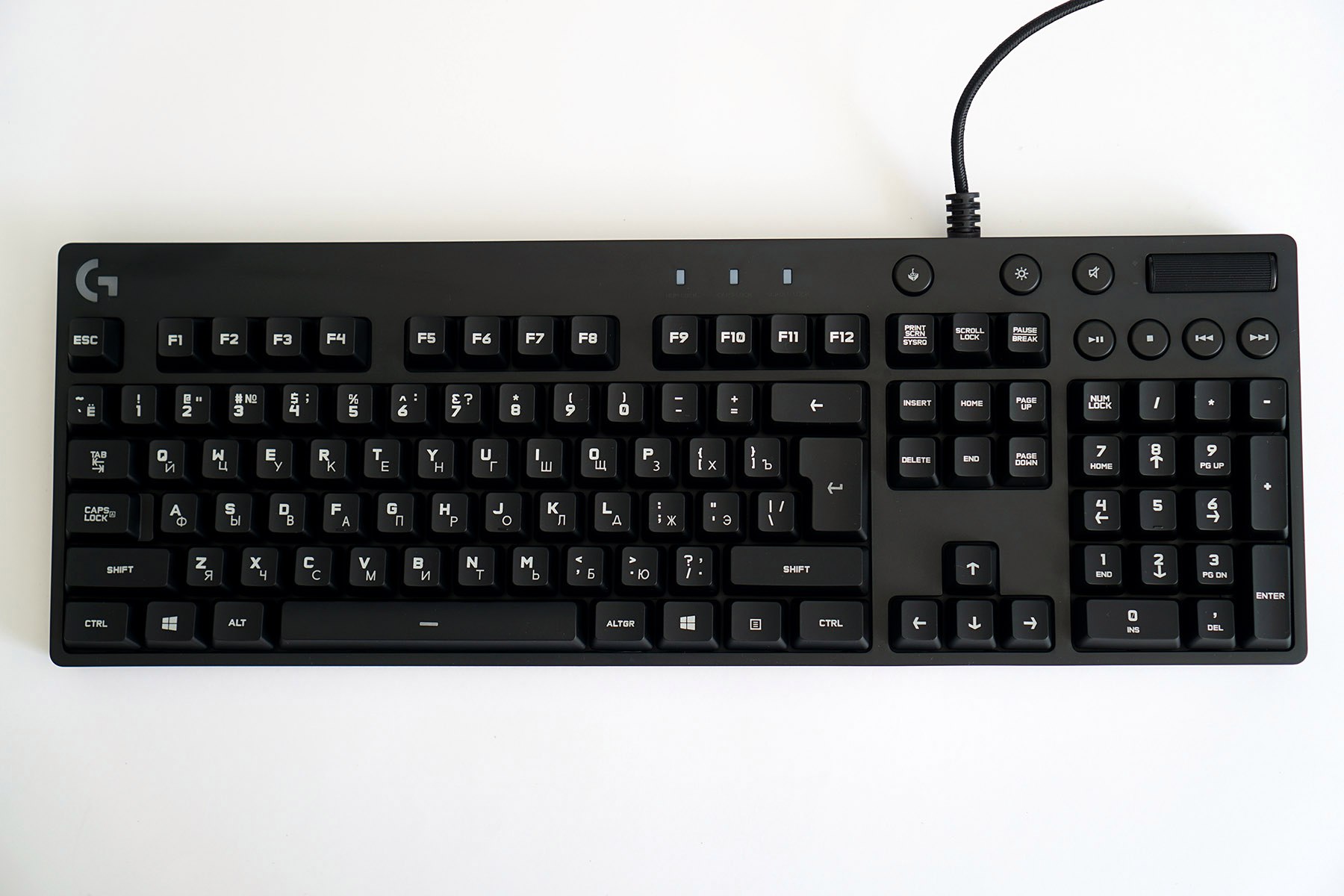
Body type - classic, strict, carefully executed, without unnecessary details. Just a rectangle without seams, and only in one place there is a cable outlet. In addition to the pleasant first impression, the solidity of the whole structure is felt - all the elements are very well matched to each other. Even without studying the keyboard to the end, I did not find something to complain about.
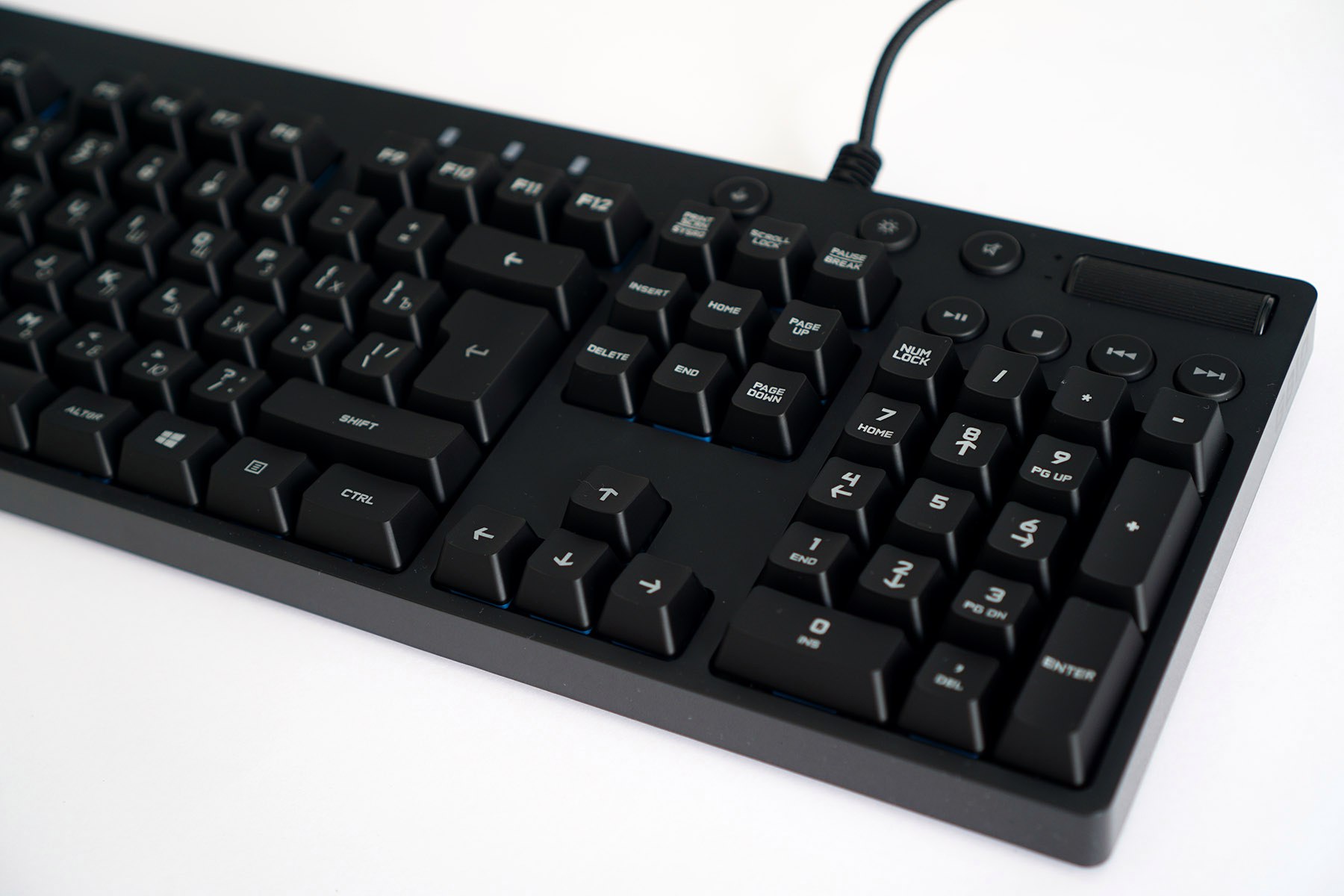
Keyboard materials are very good, but as it turned out, not the most practical. From above, the board is covered with a panel of barely rough matte plastic, on which fingerprints do not remain, but the surface still collects dust. But the entire edging of the keyboard is made of glossy plastic. In fact ... It looks nice, of course, but over time the gloss of the gloss will disappear, scratches will appear, and from the very beginning the first noticeable fingerprints will appear. I could not figure out why the usual and practical matte plastic did not suit Logitech. Apparently, while they were doing the other boards, the matte plastic was over ...
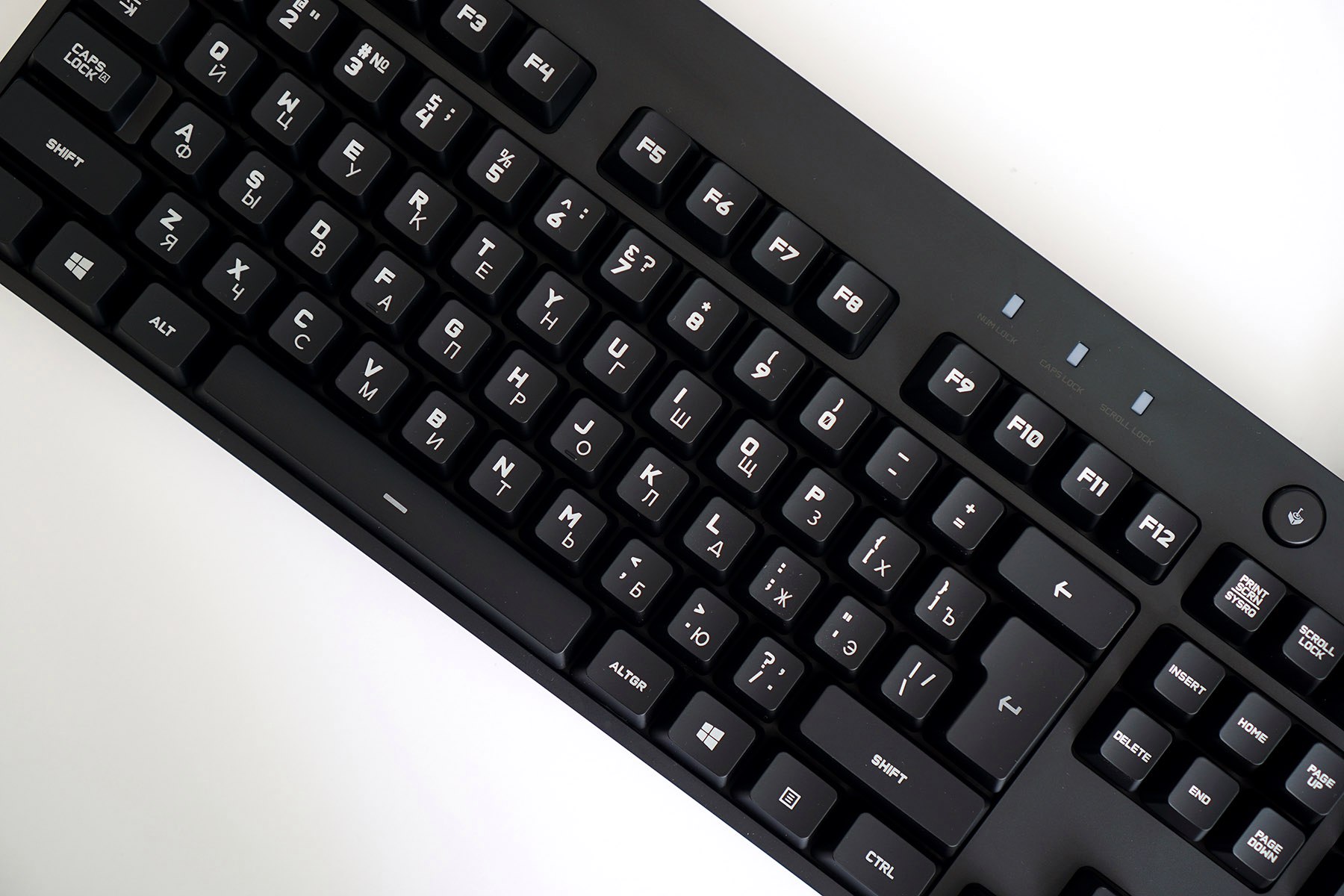
The keyboard layout is normal, but not quite. It seems to be American, but with a European twist. That is, all the same 104 standard keys, long left shift, long right shift ... And a two-storied European enteror bursts into view. This is, in fact, excellent, since so many users (especially oldfags) will prefer the two-story enter instead of the standard modern one-story.

A number of F-keys is indented from the text block of the keyboard, and at the same time the function keys are slightly shifted to the left, and therefore the “F1” starts just to the left of the “2” key. There is a noticeable indent between each quartet of F-keys. What is interesting: the keyboard does not have the “Fn” modifier, since all the additional functions are carried out separately, and no combinations of Fn + F * are provided. Everything is done through the software, I will tell you about it.
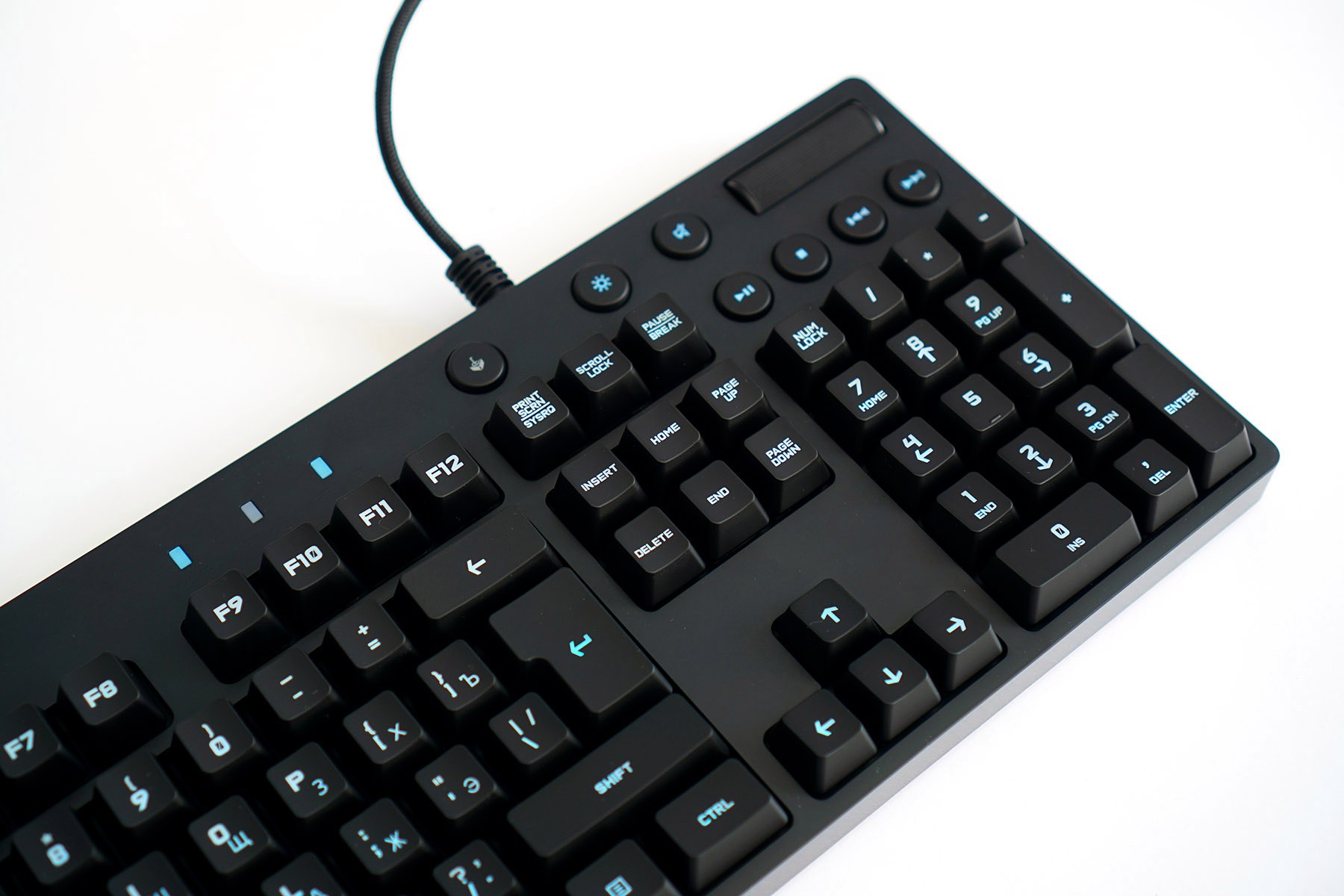
The upper part of the keyboard is enlarged due to the presence of additional keys and LEDs for displaying the operation of modifier keys (Num, Caps, Scroll). Additional keys: multimedia functions, gaming mode (locks the Windows key), turning off and on the backlight, muting and volume control wheel.

The modifier panel and additional keys are highlighted along with all the other keys, the backlight is very soft and does not hit the eyes at all.

Keyboard keyboards have a standard profile that is placed on most Cherry and similar keyboards. Keykapy G810 differ from their counterparts G410 and G910 with a normal cylindrical surface and discreet design (although quite recently there was an announcement by the official representative of Logitech, which said that the new revisions of the G910 will have standard keycaps with a cylindrical surface , like the G810).
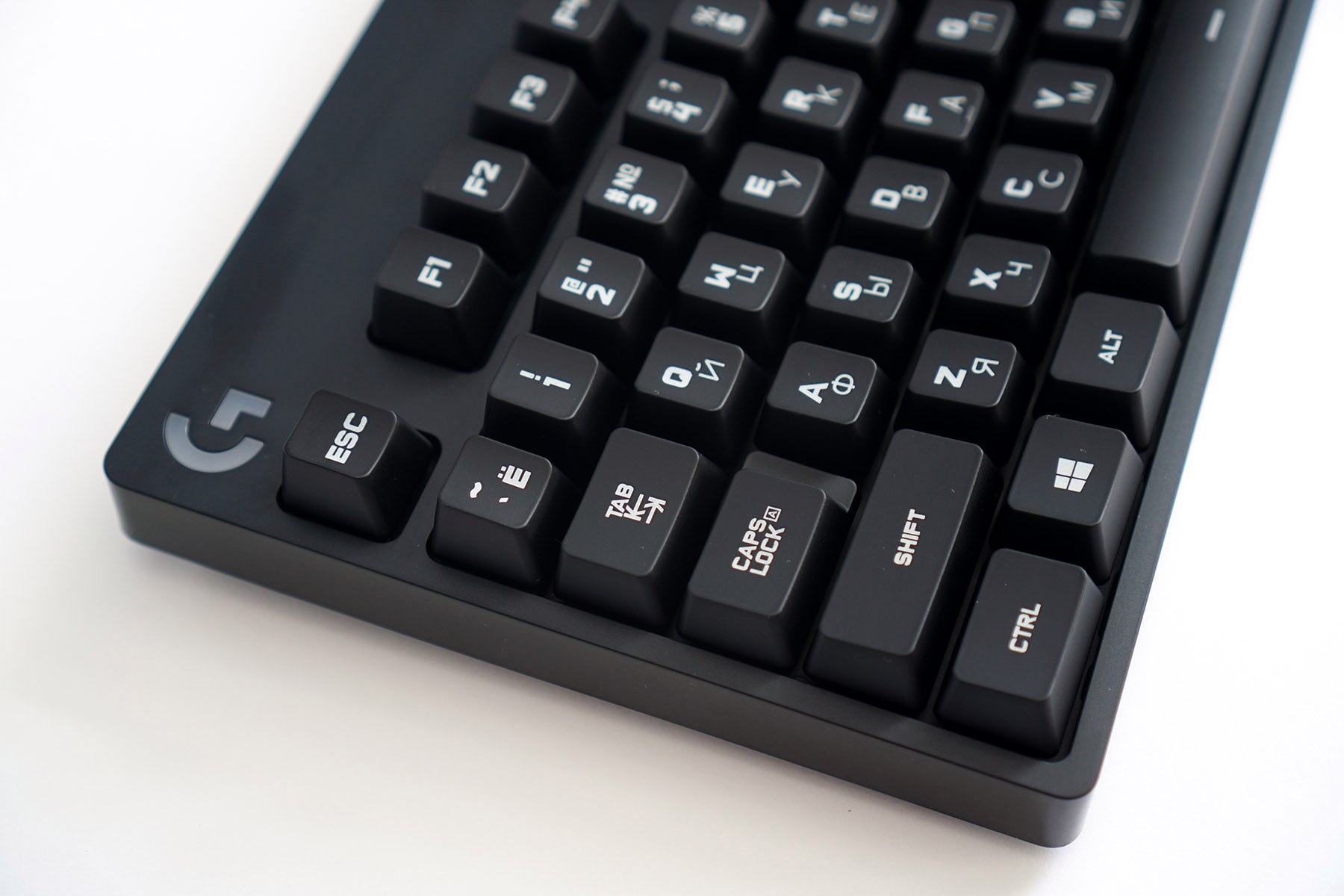
Despite the standard keycap profile, the keyboard has an unusual bottom row: the control keys on the left and right sides are significantly longer than other keycaps in the row. This was done by reducing the length of the space, but not to the detriment of it: I simply did not notice that it was shortened, so typing everything on the keyboard is also familiar and convenient, but now I’m definitely not at the control, the control is really big.
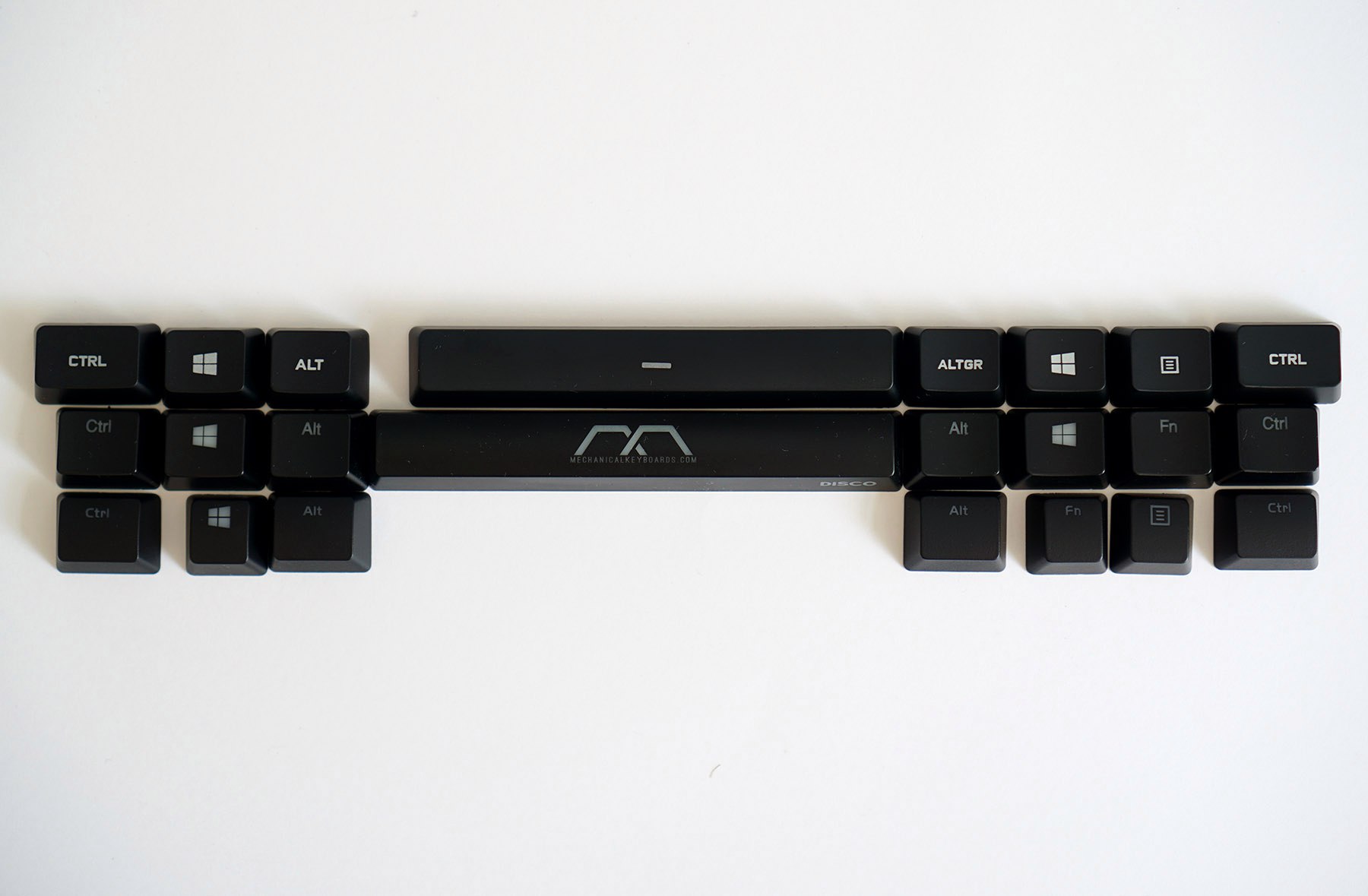
For those who are in the subject: the standard keykapy controls + Windows + alt in the classic American layout have proportions of 1.25 x 1.25 x 1.25, while in the Logitech G810 the size of the right and left controls is 1.5, and the size of the remaining keys - 1.25. It turns out that the bottom row has the formula 1.5 x 1.25 x 1.25, and the size of the gap is 5.75 versus the traditional 6.25. The unit in these proportions is taken as the size of a normal key (from a text block, for example).
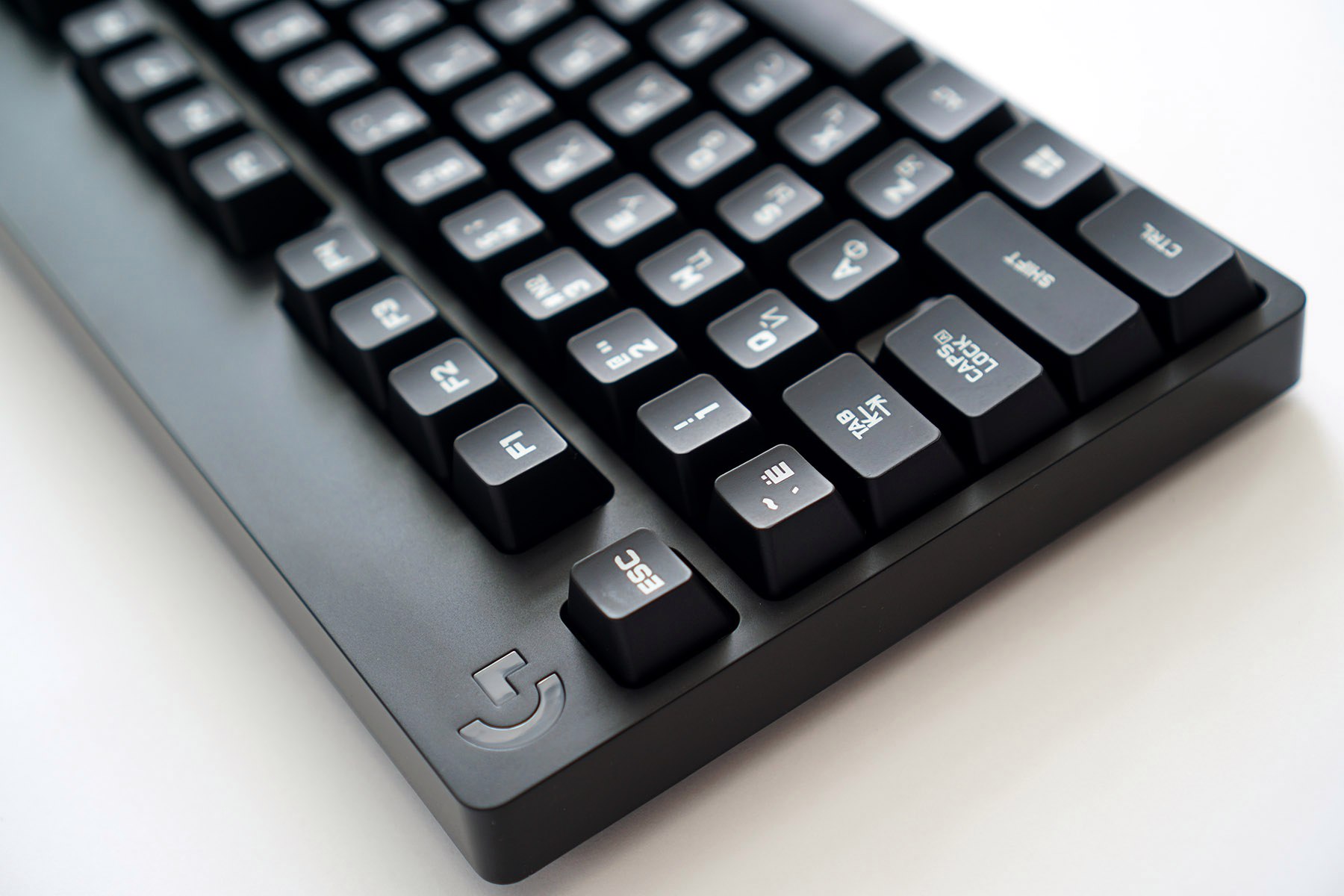
Now look closely at the keycaps. During my life I have seen quite a few keycaps, but I’ve met for the first time with the solution proposed by Logitech specifically in this keyboard. Keycaps are made of ABS plastic, on which paint is applied. Paint keycap very smooth, uniform, themselves keykapy cast strictly in shape, there are no burrs of plastic either inside or outside.
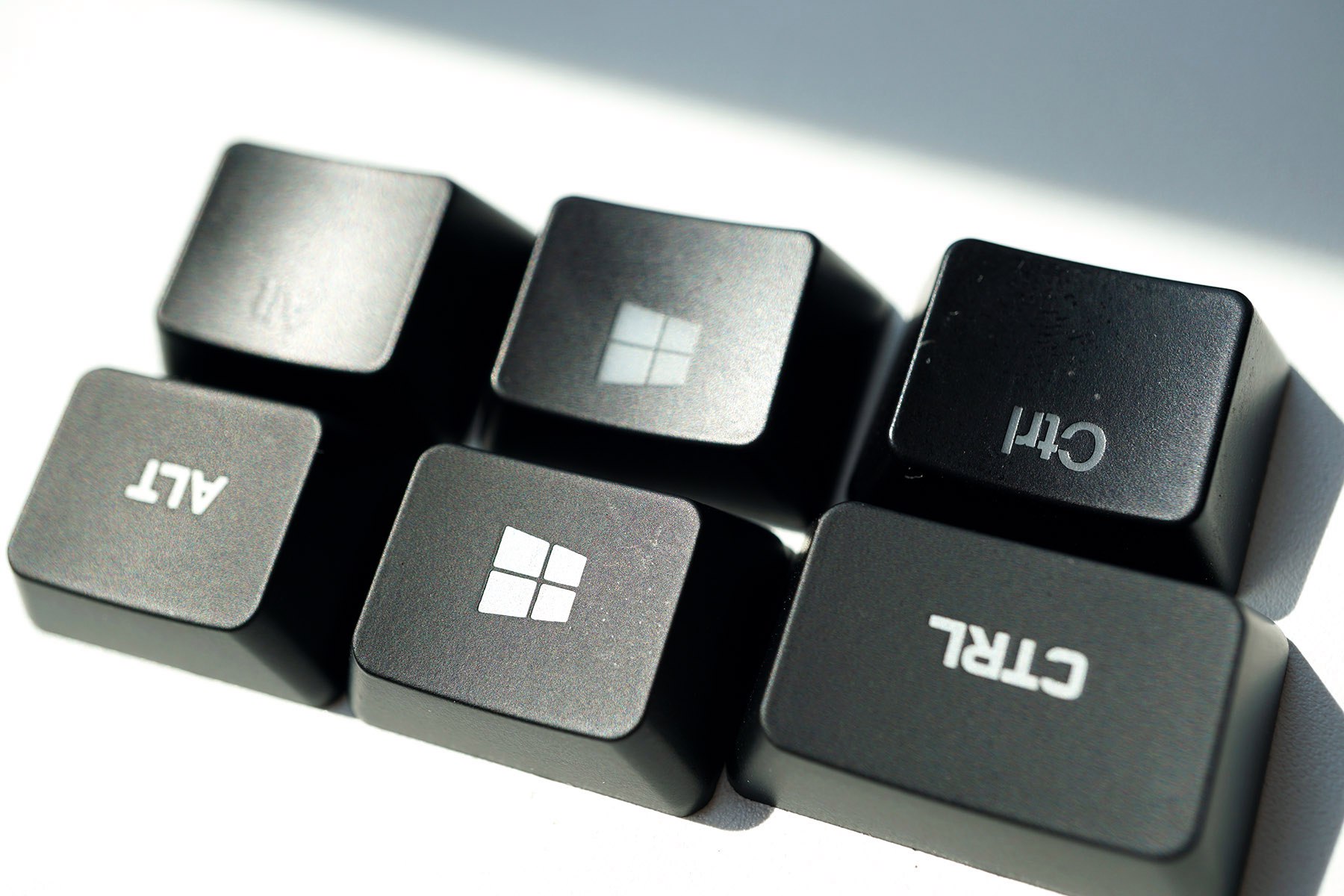
Keycaps have a pleasant finish: smooth to the touch, but very tenacious. Something of sensations they resemble soft-touch coating, but they are not rubberized. Below in the photo are the keycaps of the Logitech G810, above are the usual keycaps with laser engraving (MK Disco keyboard).
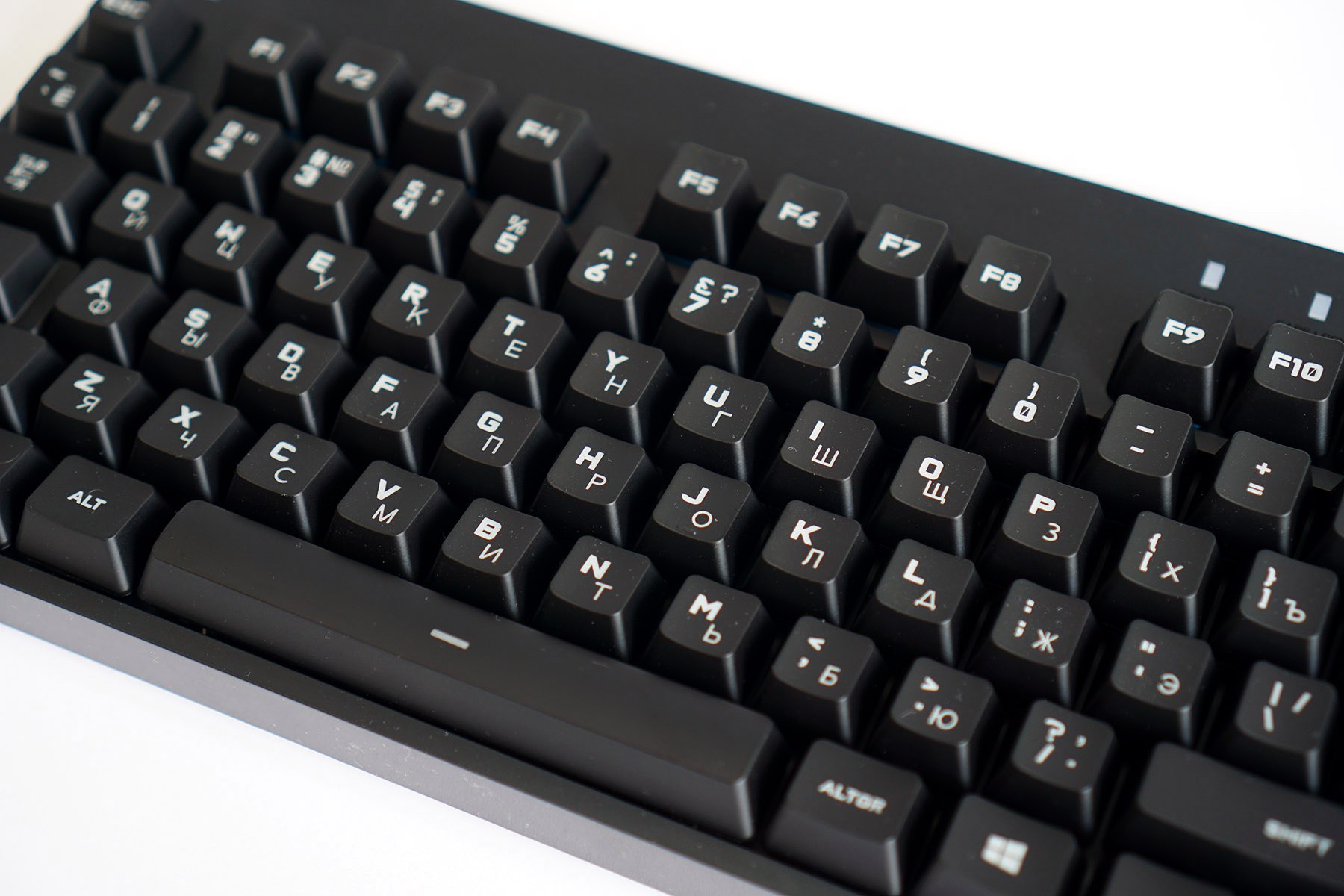
What is dry, that wet fingers very confidently hold on these keycaps and do not slide off anywhere. But these keycaps, like the surface of the keyboard, attract dust to themselves.
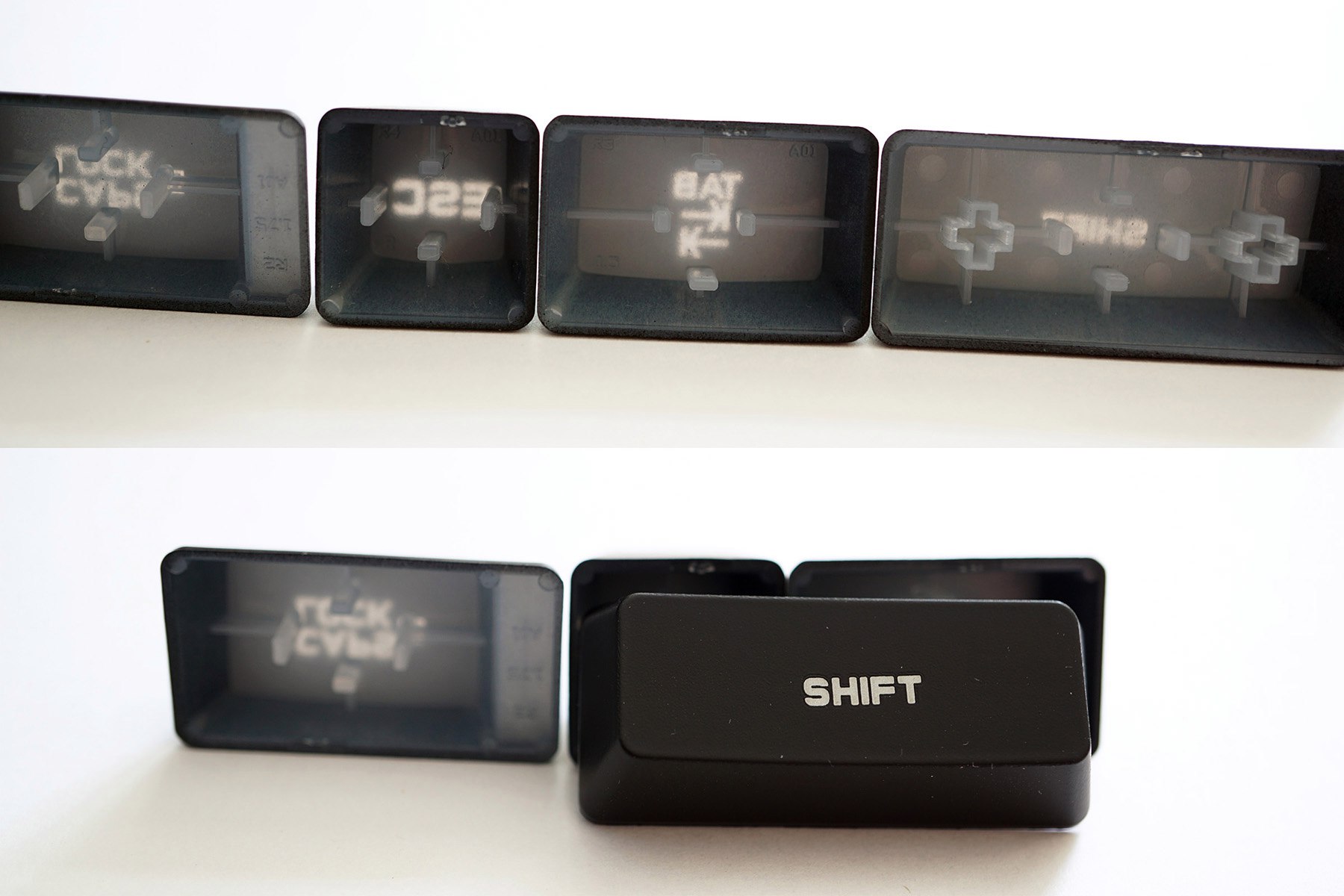
These keycaps have one unique piece: after applying the paint, laser engraving (of the Russian and English symbols) is made on the keycaps, and unusual paint is flooded into the grooves left after the laser engraving. I don't even know if it is paint, or some special polymer. The fact is that without illumination it seems as if we are facing an ordinary keycap with ordinary painting. And therefore, the applied symbol is very clearly visible in daylight.

It is necessary only to turn on the backlight, and the symbol begins to appear through, and the light goes through the keycap without tangible obstacles. This is the best solution for the implementation of keykap I have ever met. And most importantly, the keycap feels solid for a fingertip, while the other keycaps feel engraved (look again at the photo with the MK Disco). Pleasant moment. Well, the last thing I complained about is the lack of a complete set. The keycaps of the G810 are quite hard to remove with their hands, and therefore, of course, I would like to see a special puller for removing keycaps.
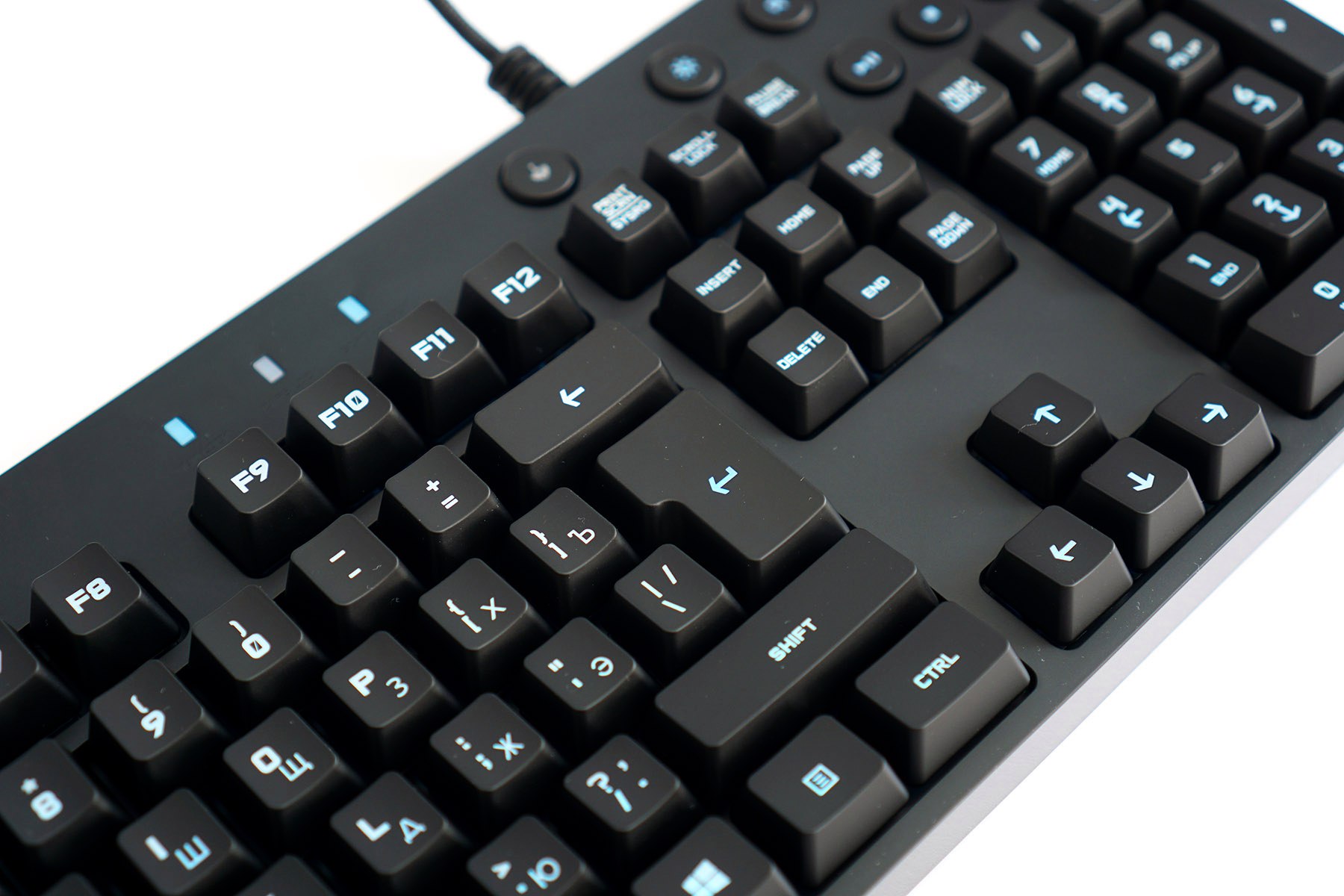
Russian and English characters differ from each other both in their outlines and in their thickness, and therefore they cannot be confused. Both symbols are located close to the center and appear through evenly. This is the merit of Romer-G switches with a LED located in the middle.
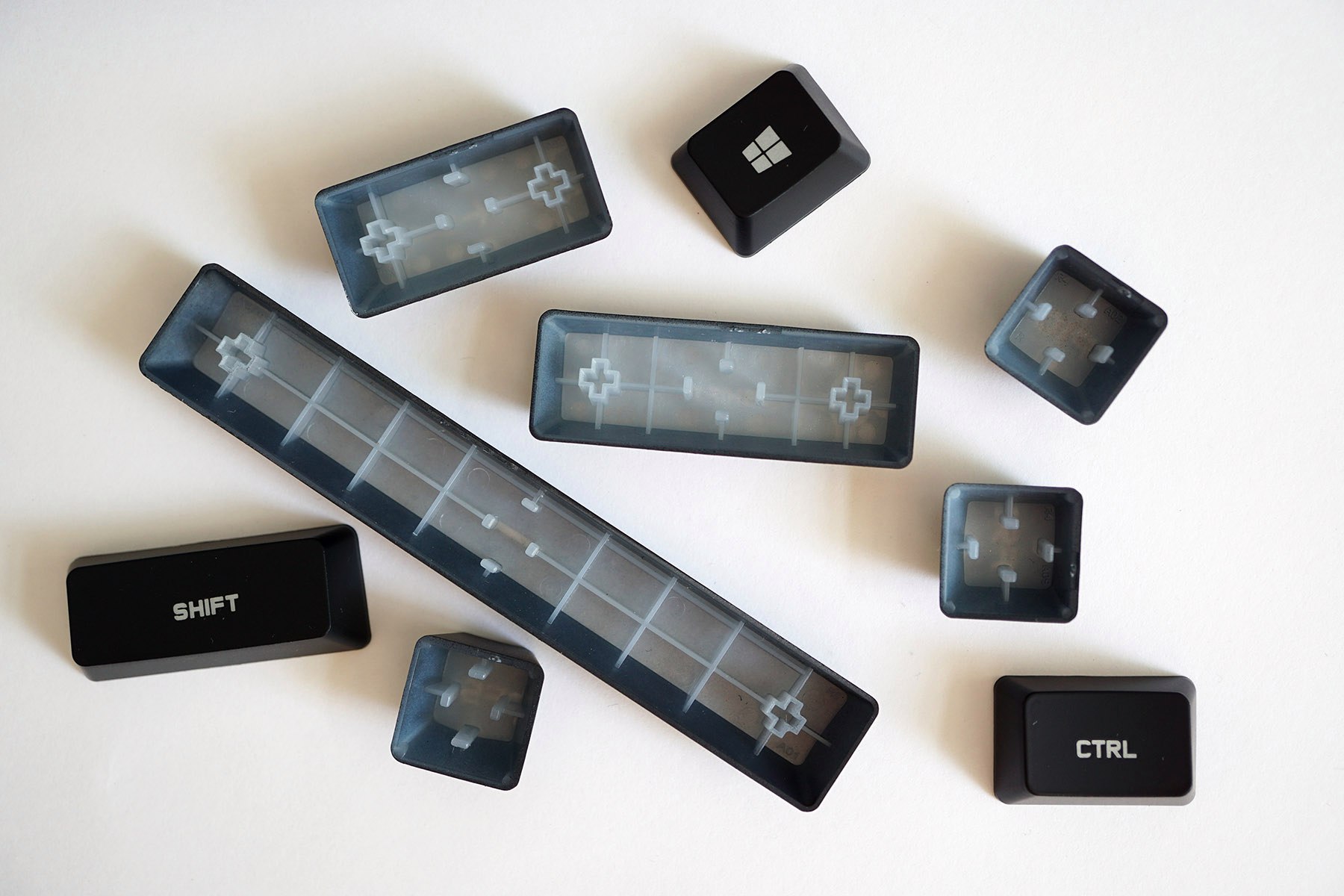
The only minus in all this is non-standard keycap connectors, and therefore it is impossible to put a different set of keycaps on the keyboard. This is due not only to the large enterter, the size of the control and the space, but also the type of mounting of the keycap with the switch - such sets are not released separately, unlike the same Cherry MX and the like. On the other hand, how often do you change keycaps on the keyboard? Here I am rare.
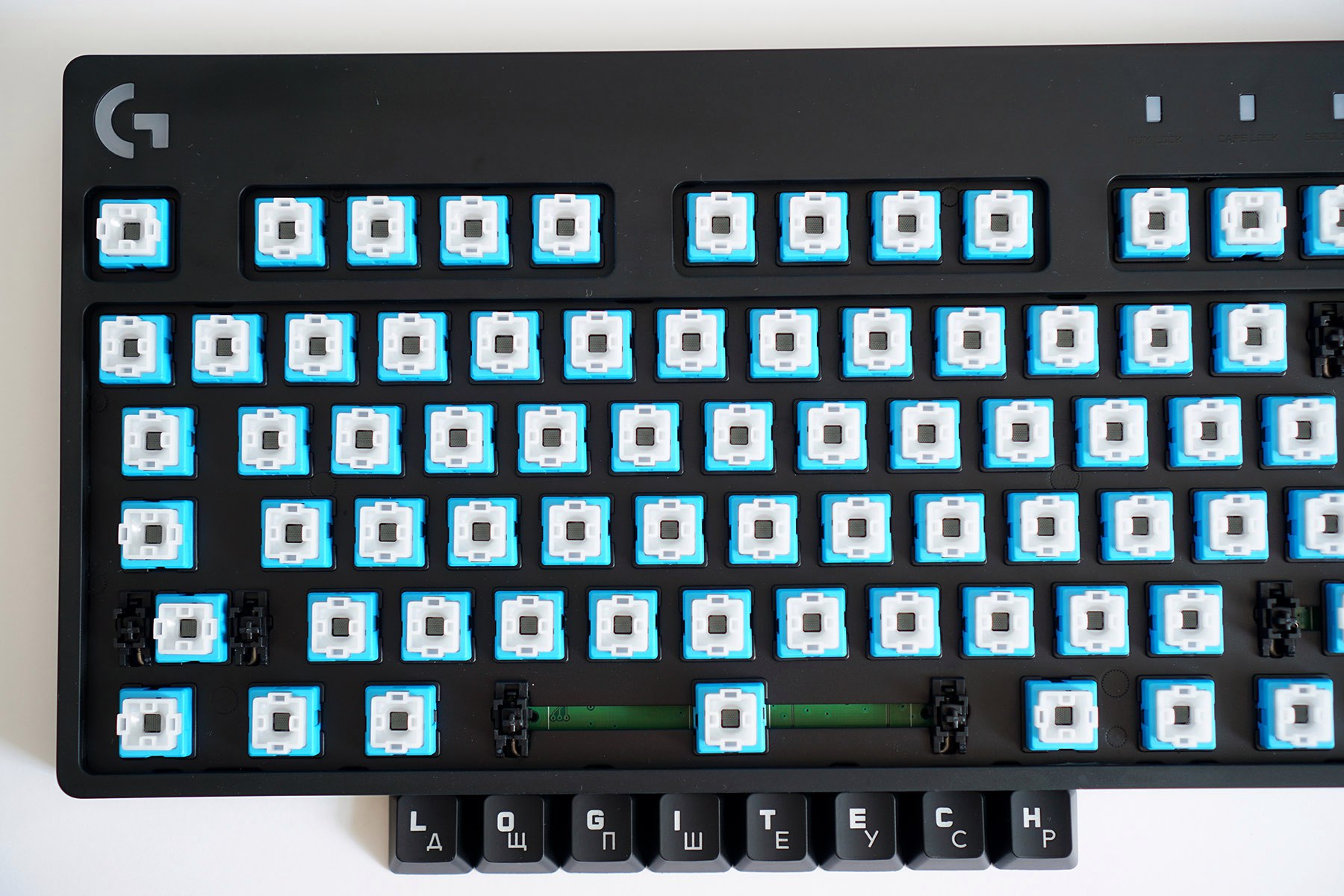
The Romer-G switches, which are developed by Logitech in collaboration with Omron, are installed in the keyboard. These switches do not have a click, have tactile feedback (when pressed, the trigger point is felt); pressing force before triggering - 45 grams, the total key travel - 3 mm.
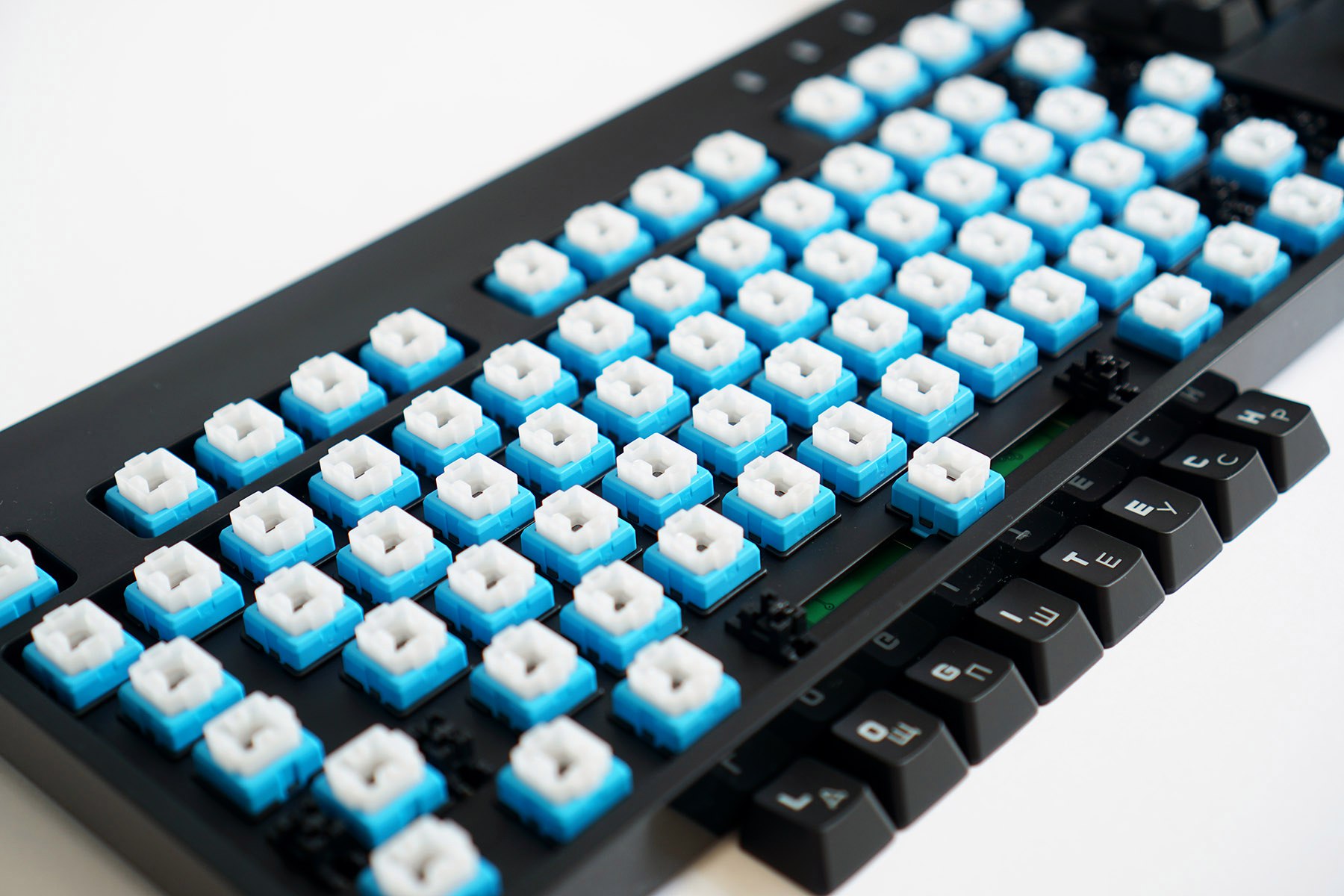
If you take the closest analogue, these switches are partially similar to the Cherry MX Brown switches (tactile, without a click, 45 grams before triggering, 4 mm until it stops), but they feel very different from typing. The manufacturer claims pressing resource at Romer-G equal to 70 million times. A serious figure, in practice, verified over the years.
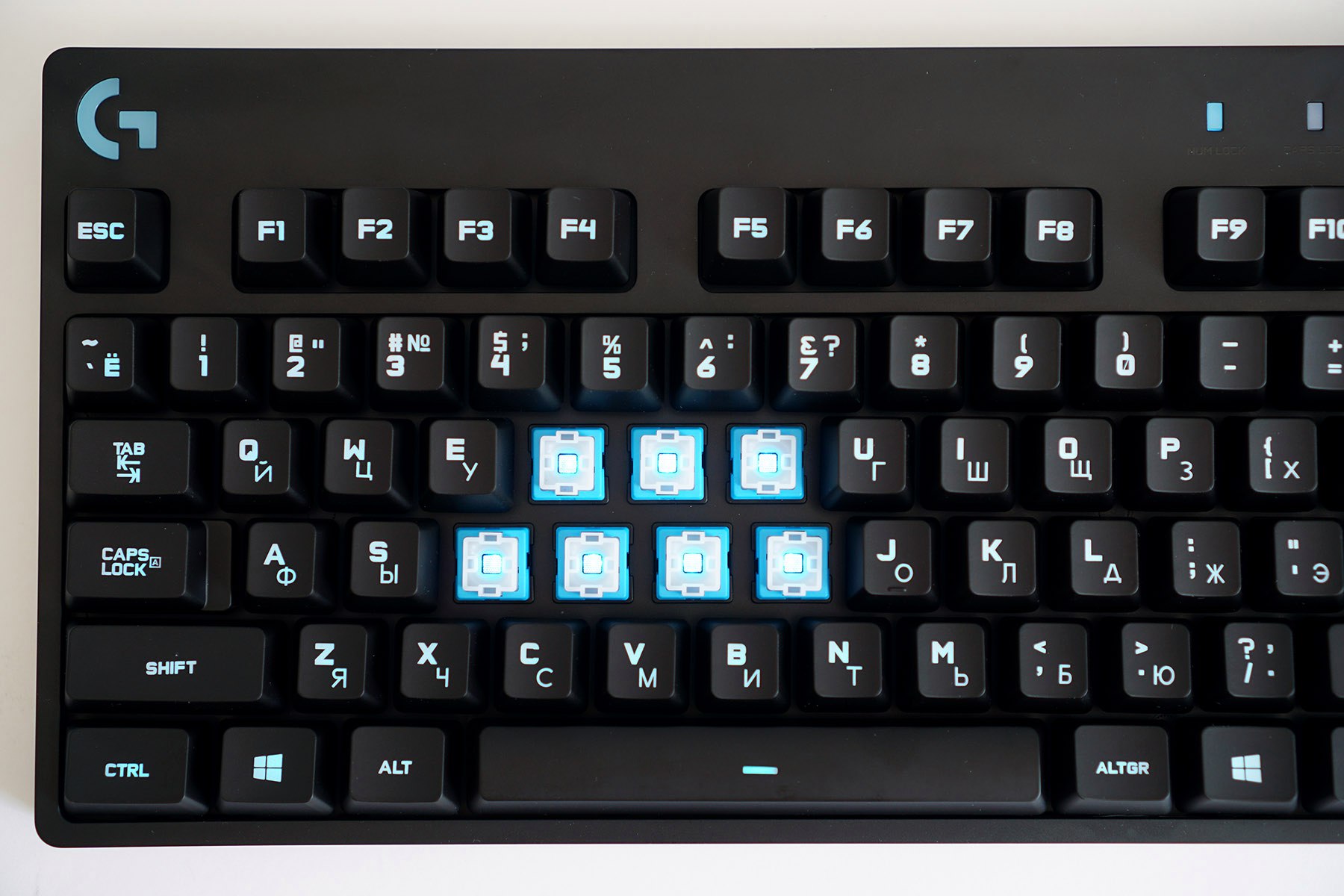
By default, the keyboard has a pleasant sky-blue backlight, which can then be customized in the company's Logitech software. The feature of the Romer-G switches backlight is that the SMD RGB LED is located exactly in the center, and the moving part of the switch is made of translucent plastic, because of which the light never hits the eyes and is very softly diffused at night. In the daytime, instead of the backlight, painting on keycaps works, so daylight will not be needed. Lit literally everything - and the keys, and additional keys, and modifiers. Reflective underlay in the keyboard is missing.
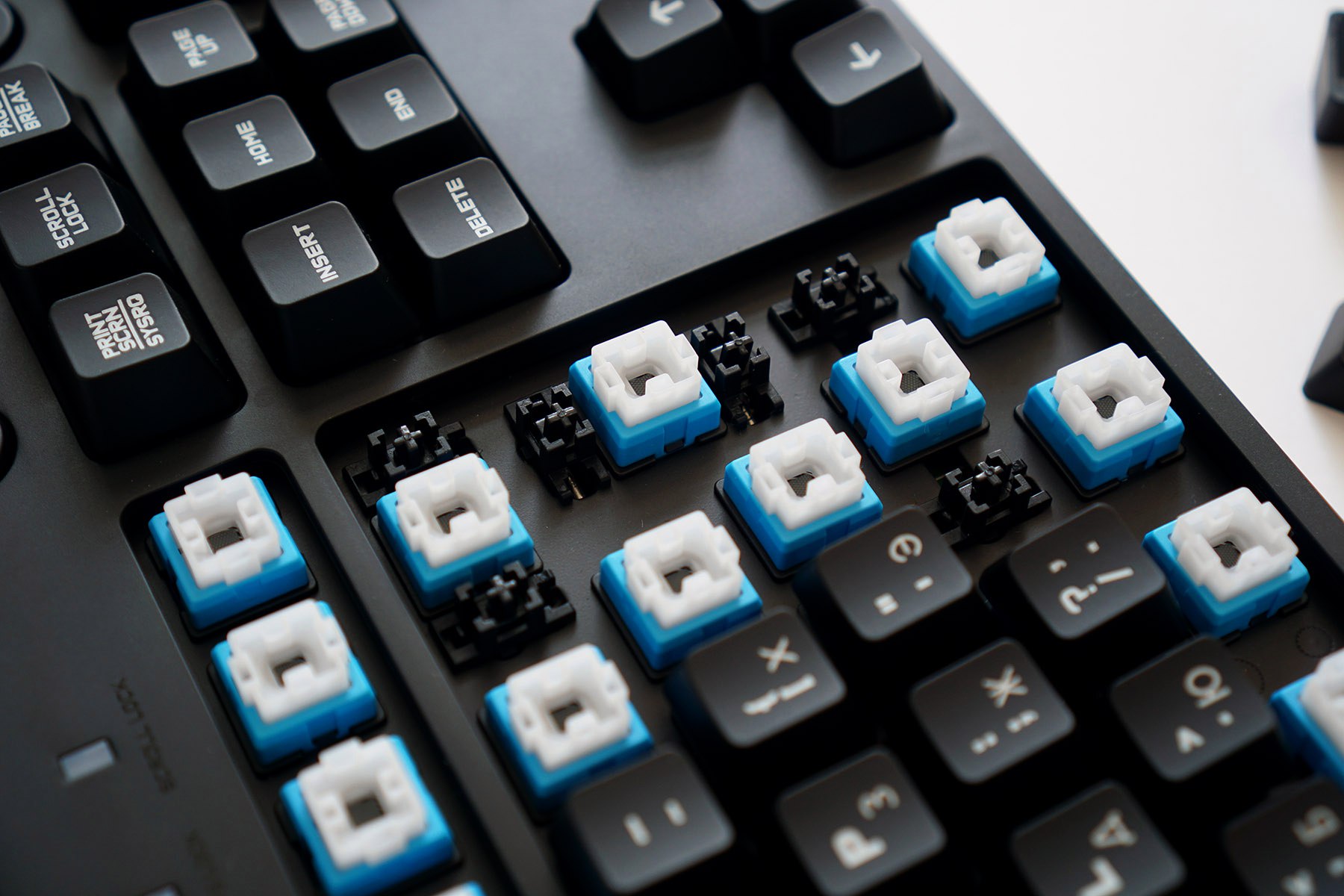
Cherry stabilizers are installed under the long keys (space, enter and others), and they are implemented in a typical way for most keyboards - they thunder a little when typing, which is why the impact sound when you press the same space stands out against the general background. Not very critical, but unpleasant.

The bottom of the keyboard is a separate topic for conversation. Ergonomics here on top. The bottom panel is made of textured plastic and it is a purely decorative element. Bottom on the keyboard is located as many as five large and soft rubber feet, which provide excellent stability of the keyboard on the table.

Neither take nor move - what is needed in intense battles. And most importantly, that one leg, located under the space, does not allow the keyboard to bend under the pressure of the hand.
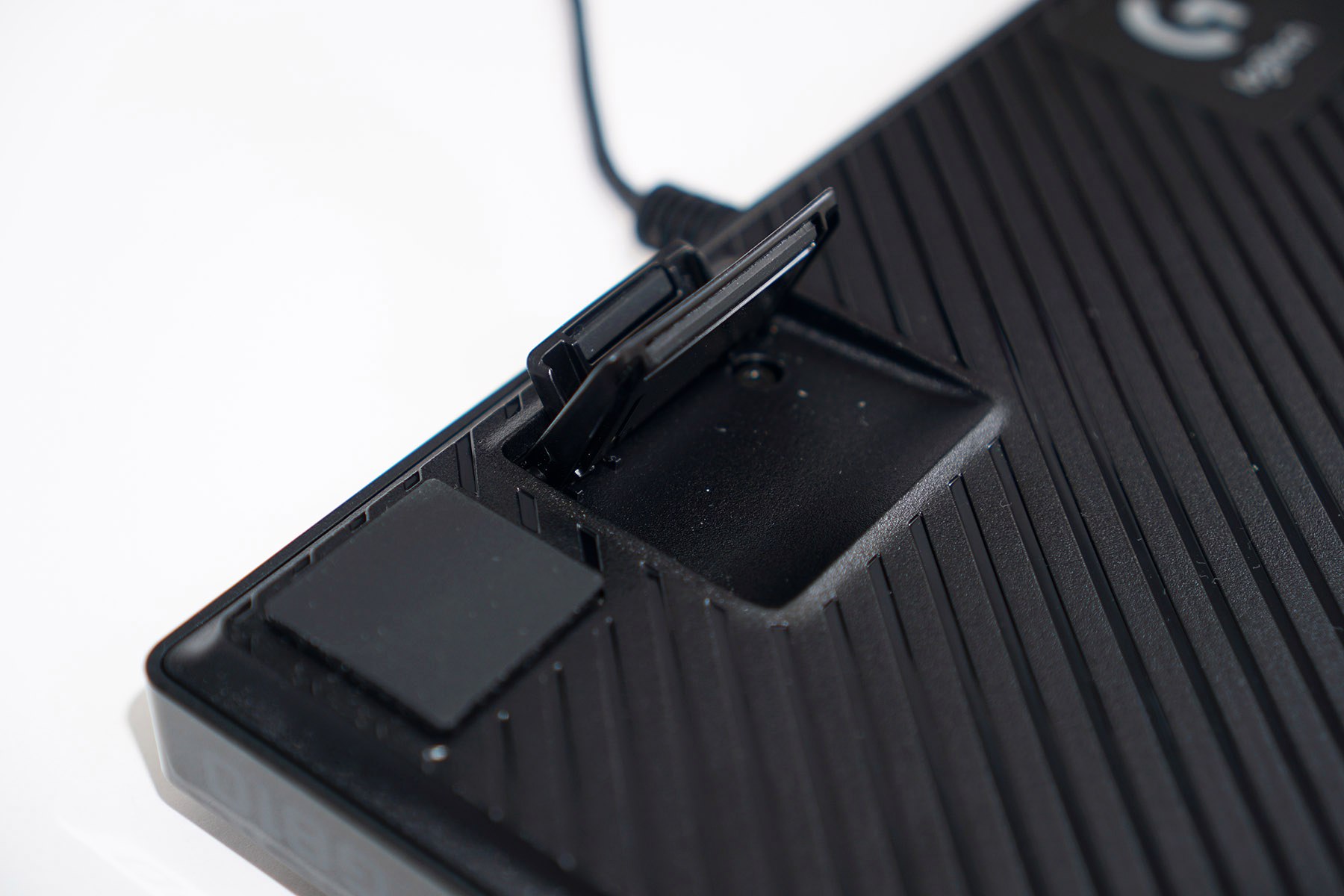
Another extremely pleasant trifle that manufacturers often slaughter is retractable legs. Here they are bunk, all these legs are rubberized, because of which the stability of the keyboard is not lost even at a different angle of inclination.
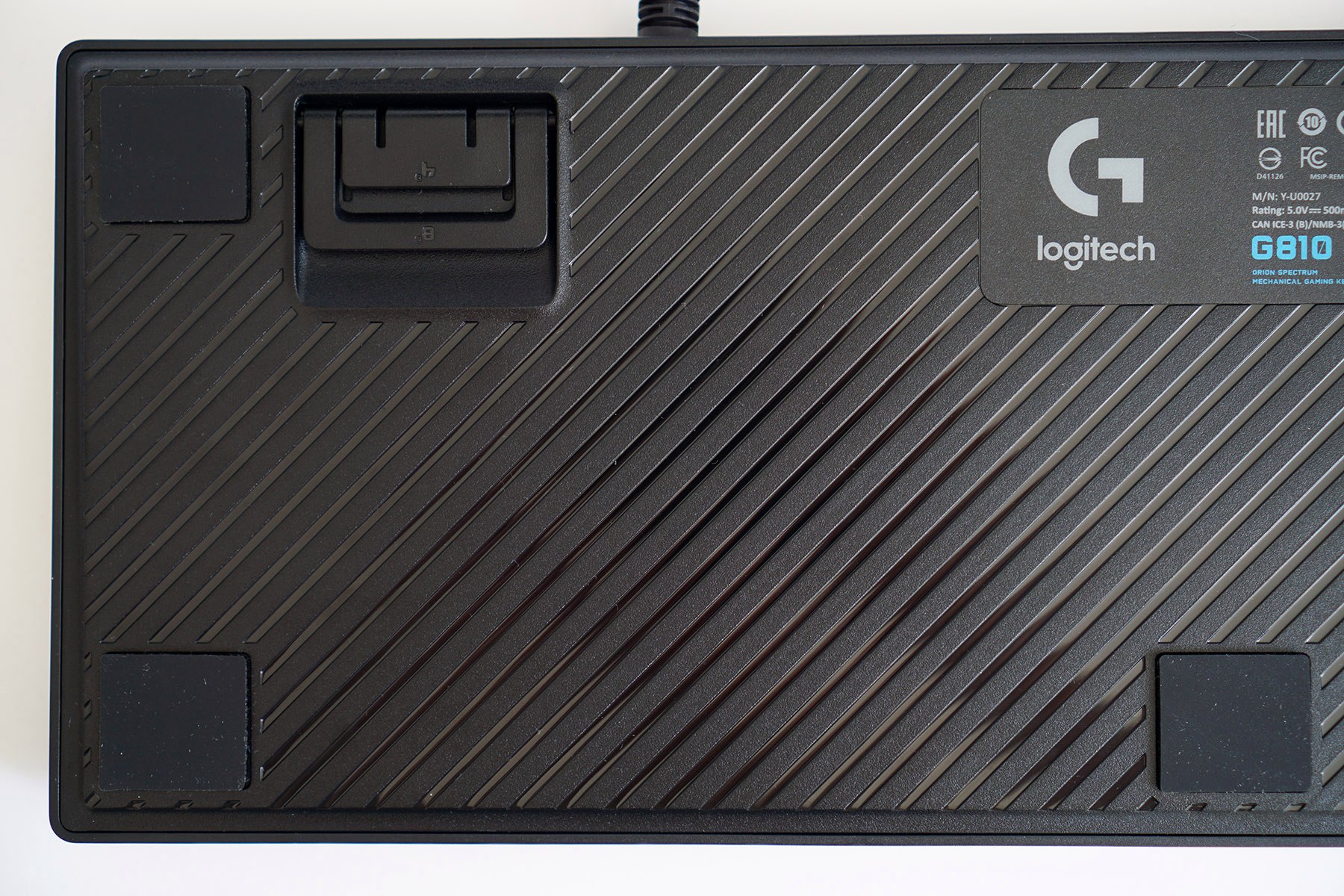
Retractable legs even signed - on each tier is the angle of inclination (4 degrees - the first tier, 8 degrees - the second). And they are easy to push and slide, all these actions are accompanied by a slight click. Amazing I have nothing more to add.
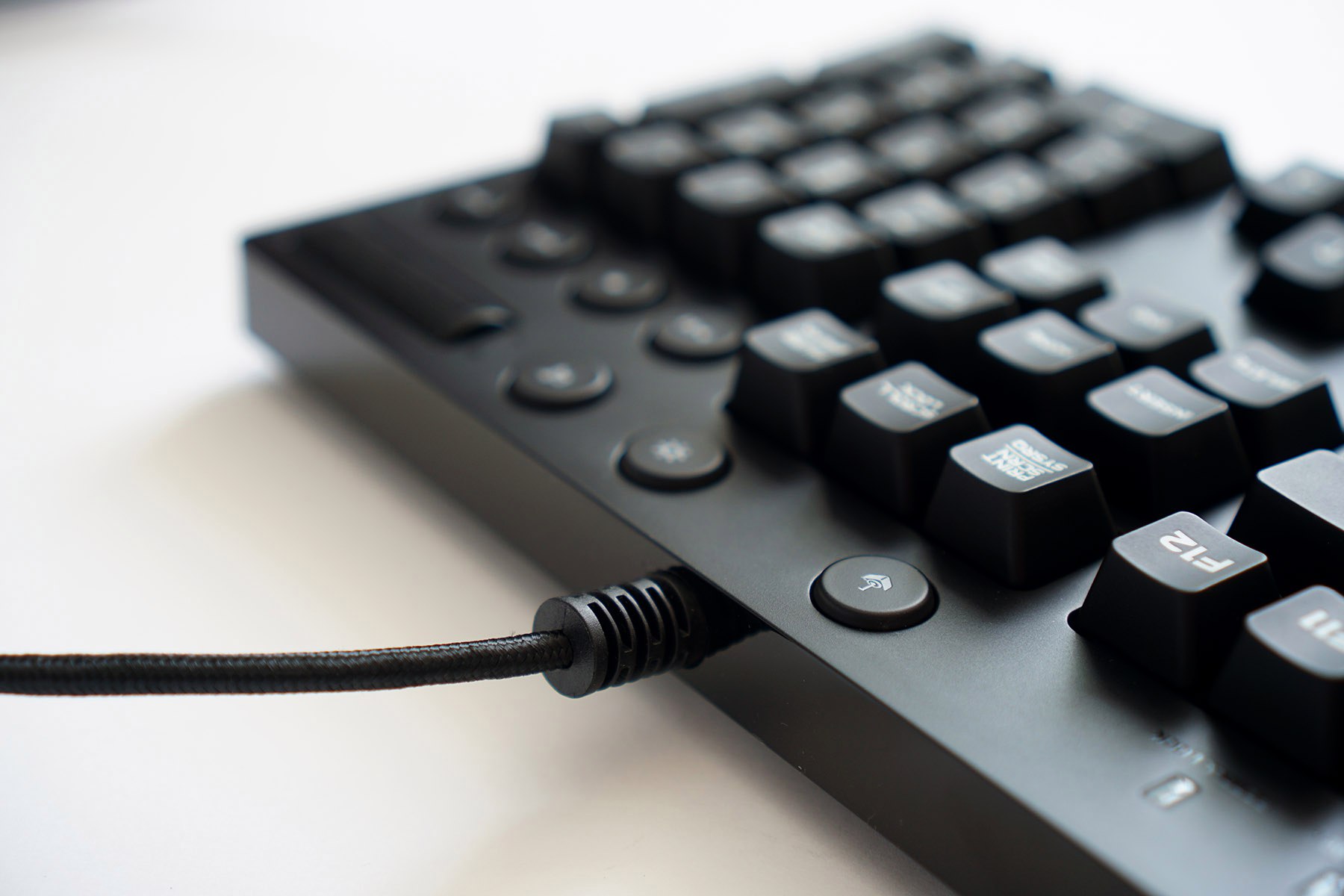
The cable of the keyboard goes to the right of the middle and has at the output protection against bending. The cable is moderately thick (thicker than that of the Logitech G502, but here it is at least in the order of things), wrapped in a fabric braid, unbent without resistance, and remembers the specified shape. Cable length - 1.8 meters.

The keyboard cable connector is made in the same aesthetics as the keyboard itself - neat, simple, elegant.
Yusb 2.0, without gilding.
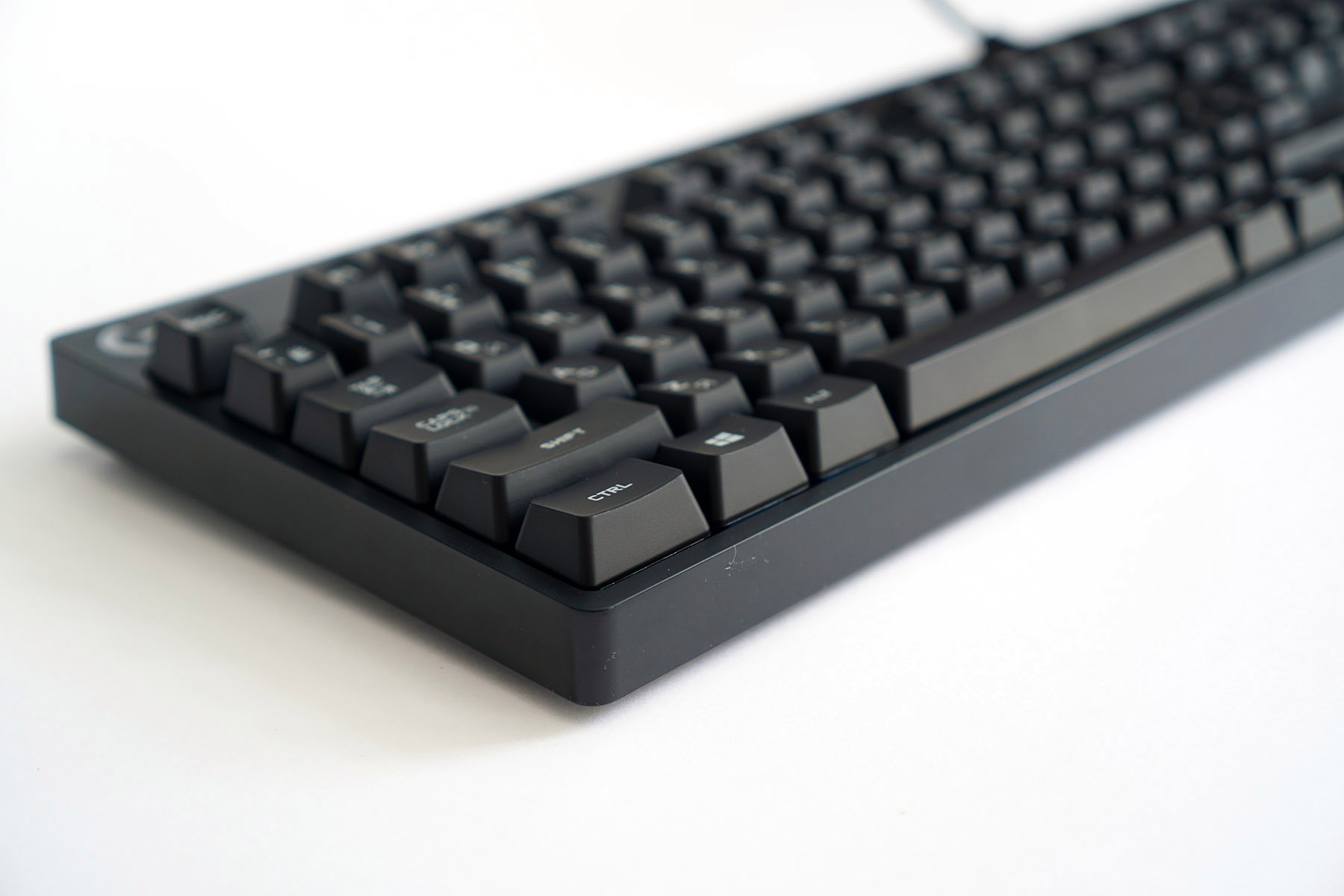
The keyboard leaves a very pleasant impression. She has a huge baggage of features, but they all do not interfere in any way in the usual operation - on the contrary, these features very quickly take root and become the hallmark of the keyboard. And, most importantly, all these chips work.
There are drawbacks, of course. Gloss won still dirty. But against the background of the overall performance, such trifles are simply lost, so you should not focus on them. Separately, I would like to note the excellent build quality, solidity of the structure and the absence of any backlash, squeaks and cracks.
Software, backlight capabilities
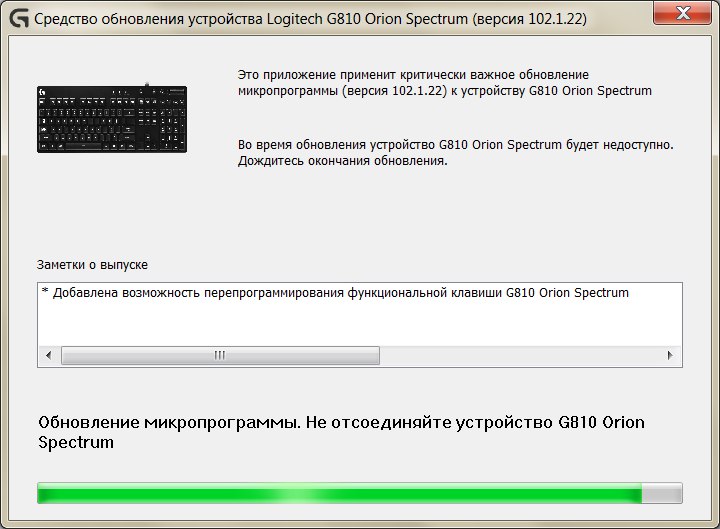
The keyboard, like the entire Logitech gaming product line, has a common software - Logitech Gaming Software. After installation, it is desirable to update the keyboard firmware to enable all its functions. The latest version of the firmware adds G-keys - additional functions of the keys F1 - F12, which you can score anything you like. To update the firmware, you need to disconnect and connect the keyboard, then start the update process, and at this time you should not disconnect the keyboard.
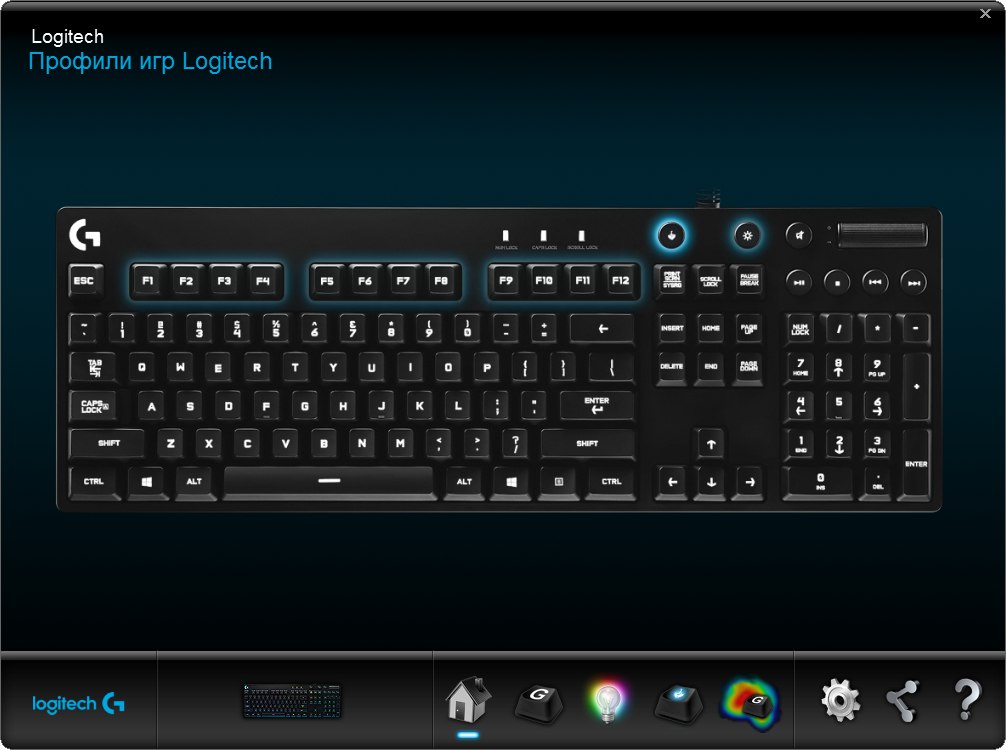
In the main window of the software, a keyboard is displayed on which the settings for its configuration are highlighted. Poked on the key from the F-series - went into these settings, in the backlight key - forward to adjust the keyboard backlight.
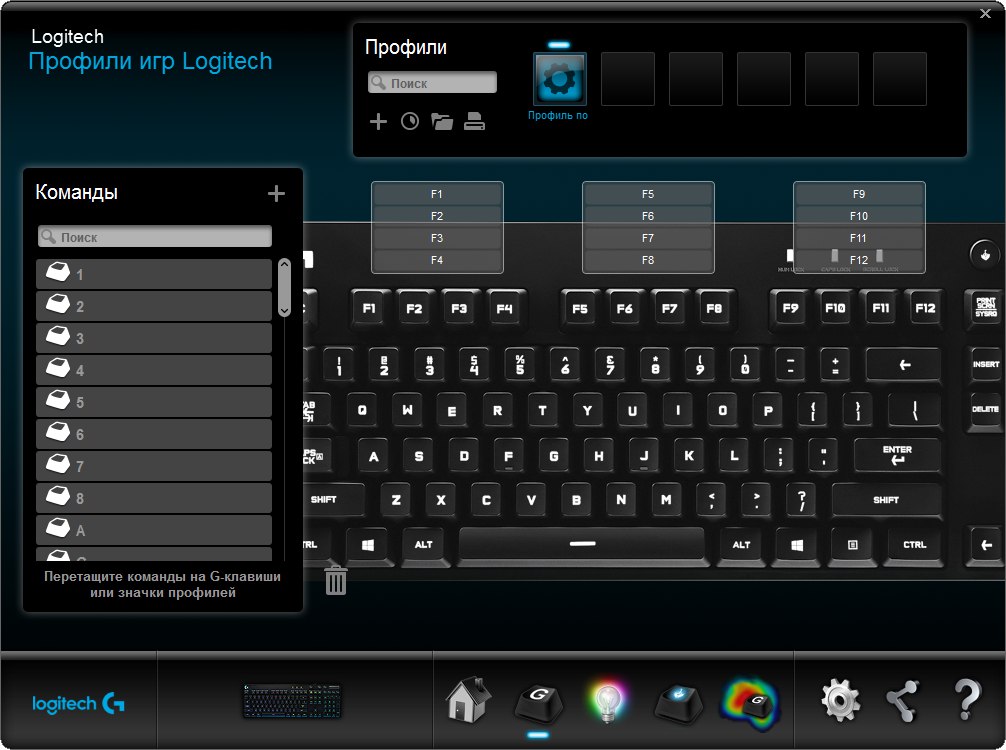
And here are the very G-keys for which the update was made. Briefly about the main thing: you can not reprogram the keys in the keyboard. Like this. You can create profiles, you can run these profiles automatically, just bind a profile to a specific application, you can put the most incredible illumination options for every taste, color and light in each profile ... But you can score a macro, launch a program or do something other than standard pressing one of the keys is impossible. Except for those F1 - F12. This is just nonsense.
In any, even the Raiser clave itself, in any profile you can score any key on any key. Or almost any. Here, only on a number of F-keys. In fact, instead of those very combinations Fn + F *. Absolutely unexplainable restriction. Fans of riding CS: GO with binders and office workers holding the entire office-software package on a digital keyboard will break off. Only G-keys, only hardcore. They simply replace the standard F-key functions. Well, maybe it is for the better - the annoying help will not come out if you accidentally press "F1".
All this greatly reduces the ability to customize the keyboard for themselves. But this does not end there. Here is another fly in the ointment: the keyboard has no internal memory, and therefore only the last saved settings are stored. Was a certain backlight set? When the software is turned off, it will be reset to the “color wave” effect, which goes by default (before the firmware update there was a static sky-blue backlight). You can change something only through the software, where there are profiles created. It turns out that the keyboard is highly dependent on software, and software, in turn, puts the stick in the
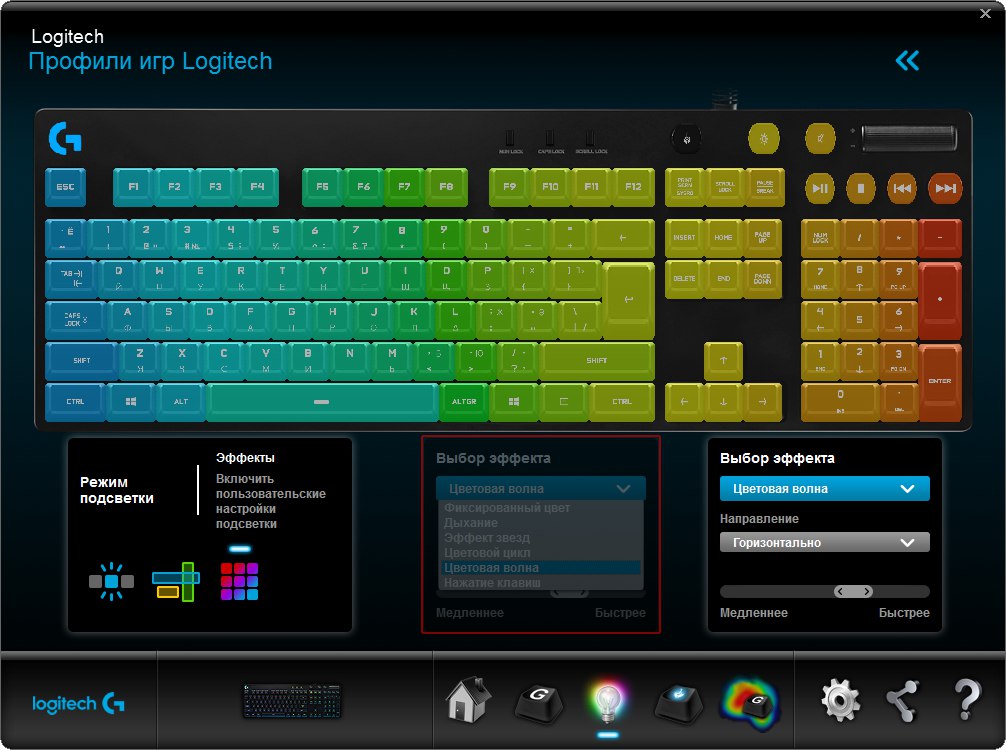
But the backlight settings at Logitech are just great. There are three different tuning options: effects, zone tuning and free style. Here are the backlight capabilities in the effects mode. There are not many of them, but they are beautiful and perfectly show how good the backlight of the G810 is. I rendered all the effects in a red frame for clarity, and the current effect is shown on the right. Each effect has additional settings like direction or speed.
But there are nuances. For example, in reactive mode (in software, this mode is called Keystroke). This is the mode in which the pressed key lights up, and then gradually fades out. Here, after pressing, the key fades with a “stepwise” effect: the gradations of key attenuation are visible (while in many keyboards the LED goes out very smoothly and linearly). I suspect that this is already software flaws, and not restrictions on the work of the backlight itself - after all, the “color wave” mode works fine. I would like these moments to work out a little more detail.
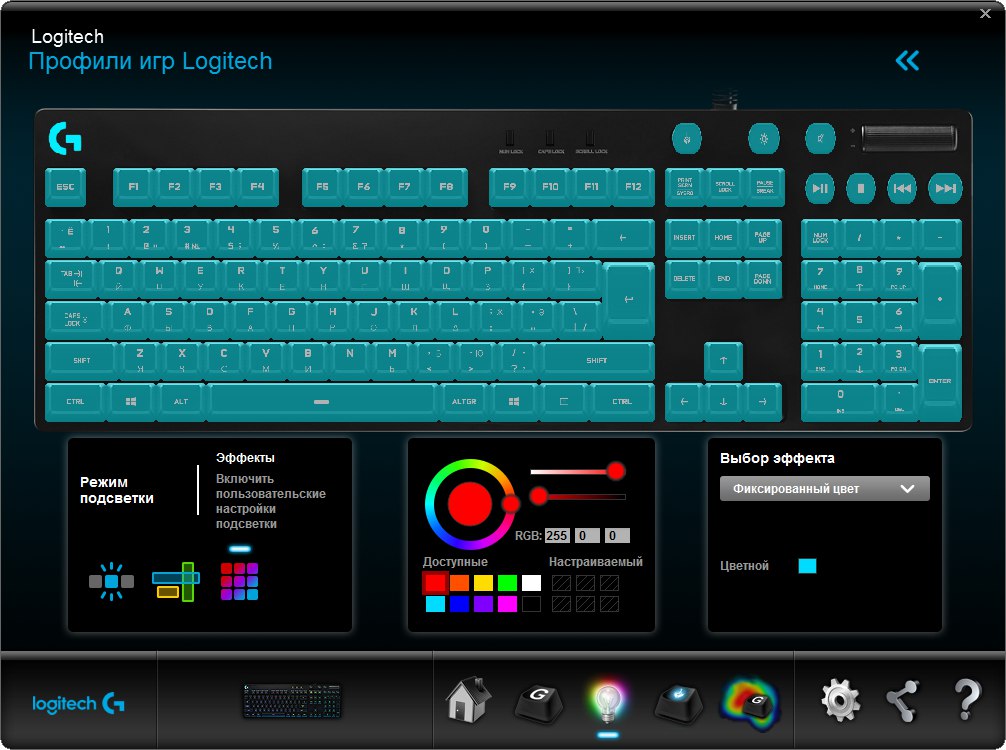
But it is worth paying tribute - setting the backlight is very pleasant, simple and clear. You can choose a regular fixed color and enjoy the backlight work. In addition, everything else is easily configured: there is a choice among standard colors, there is a contrast setting (upper slider) and brightness (lower slider). Without software, again, nothing can be configured.
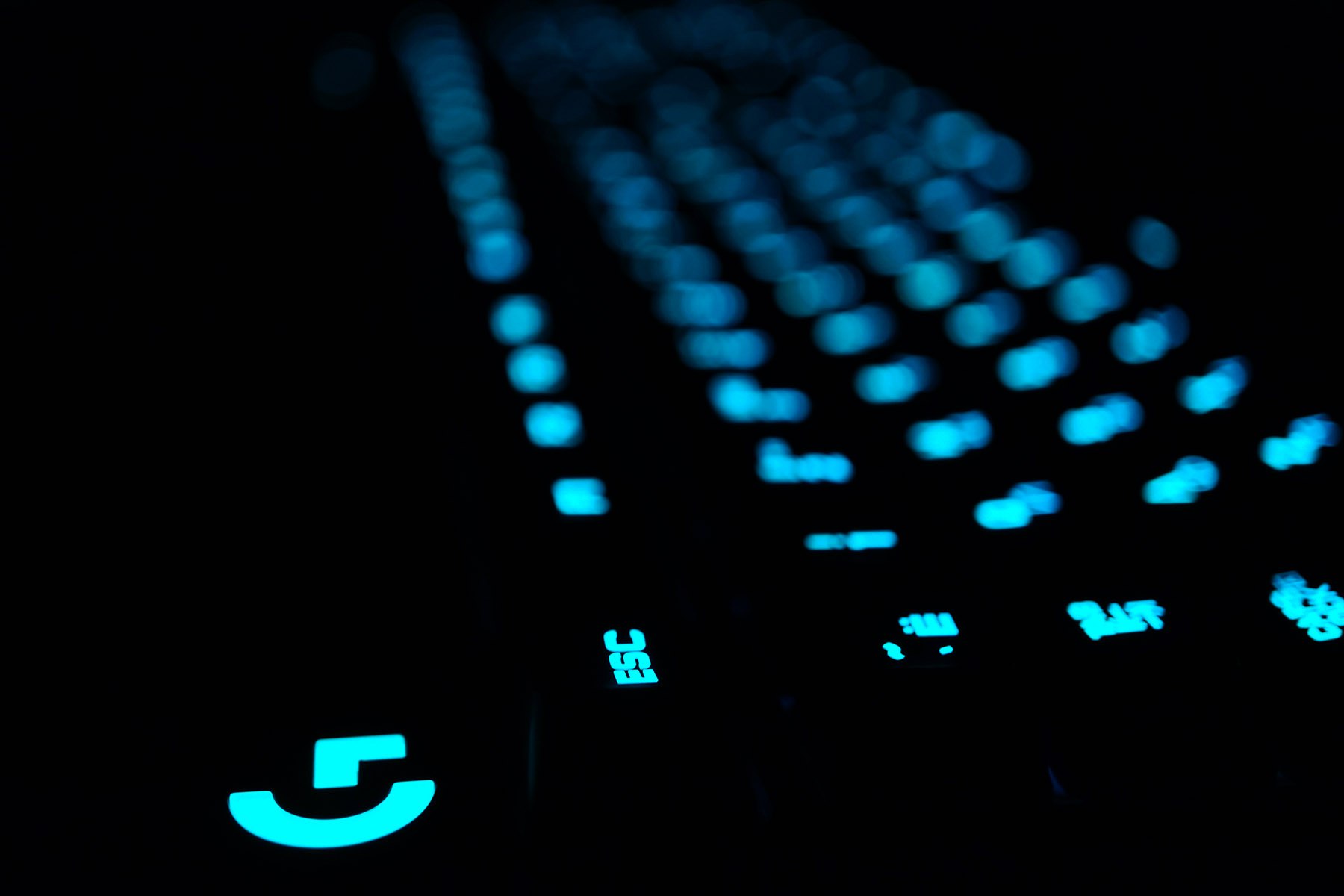
Another good news is that the backlight is configured literally everywhere - from the “G” logo and additional buttons to modifier lights. The keyboard cannot reproduce pure white color, but the impossible cannot be demanded from RGB LEDs. White in particular at Logitech gives a blueness, and this is better than the parasitic shades of purple or pink, which are found in most RGB keyboards. The photo shows the standard blue lights at night.
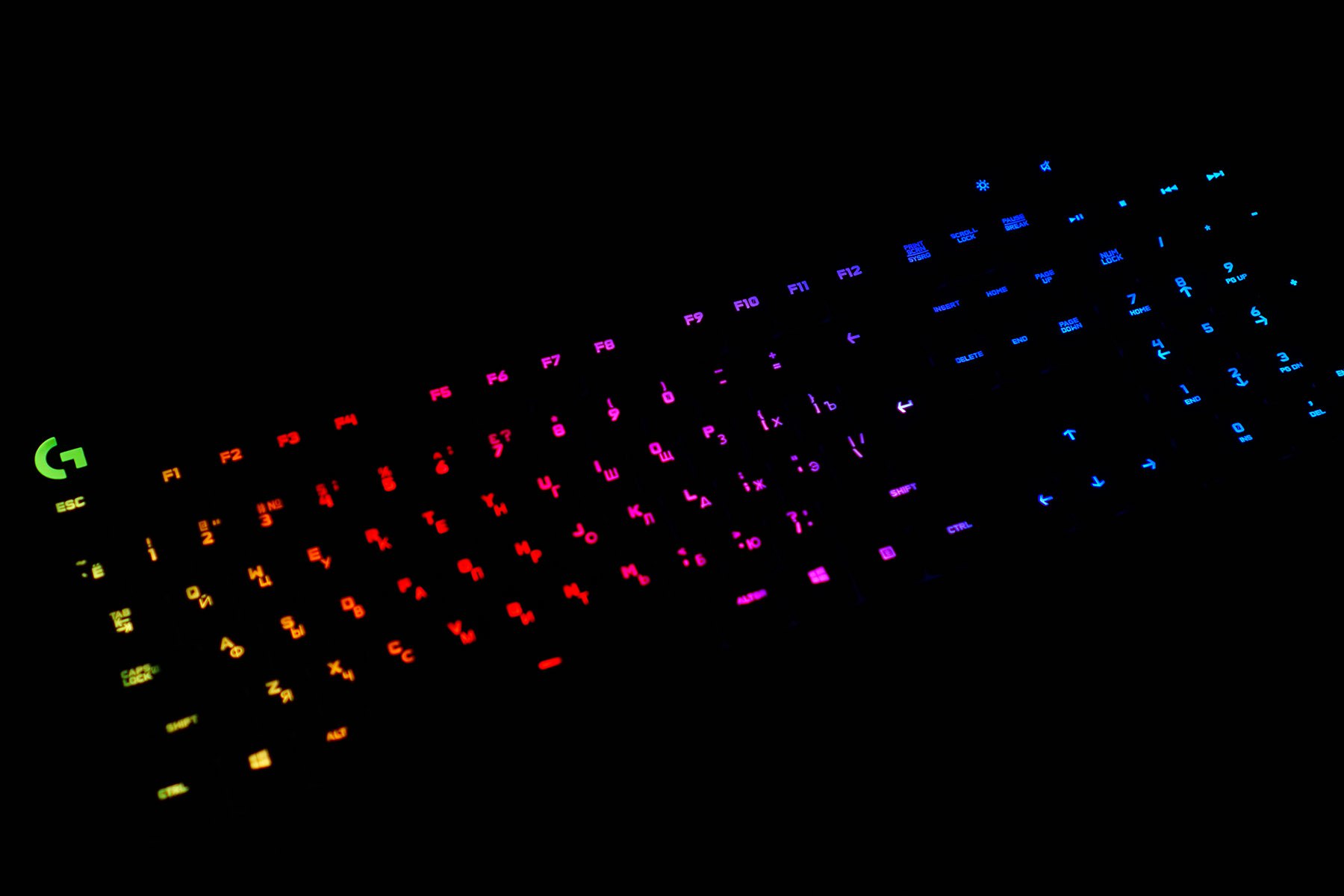
In general, the backlight of the keyboard is very pleasant, juicy and soft. In daylight, it is not so noticeable, but in the daytime it is not needed - the characters are visible due to painting on keycaps. And at night, the brightness is quite enough, and at maximum brightness, the eyes do not get tired of the backlight at all.
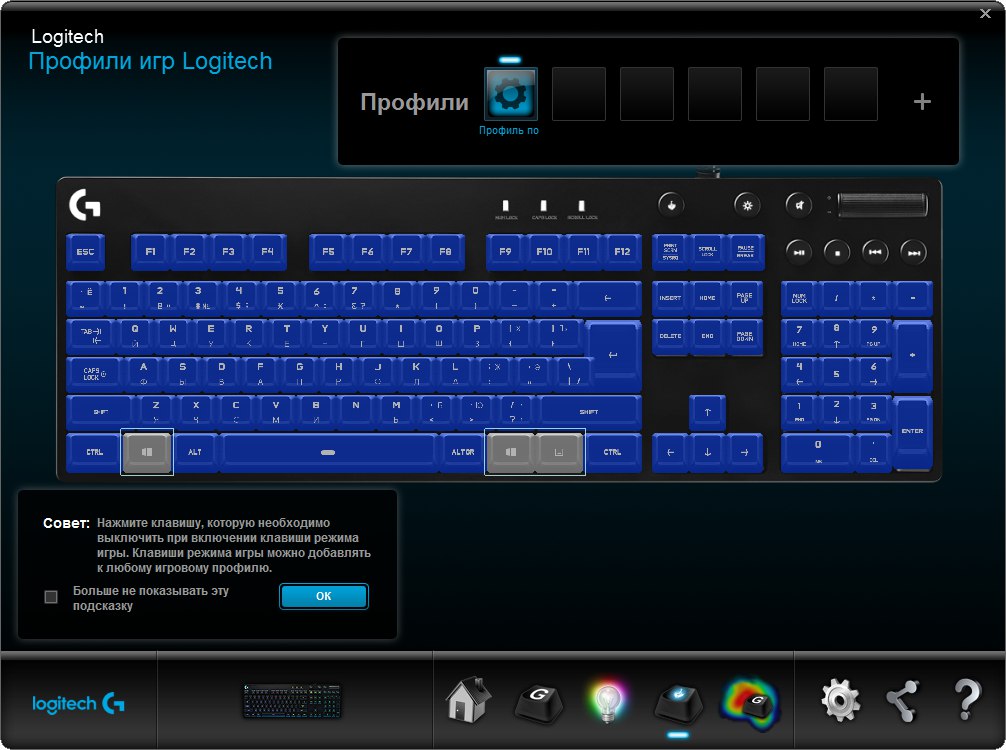
A separate tab for setting the game mode. They poked a button on the screen - when the game mode is activated, the buttons selected in the software will not work. You can disable only the Windows keys and pop-up menu, and you can turn off at least half the keyboard. For each profile created, you can create your own game layouts.
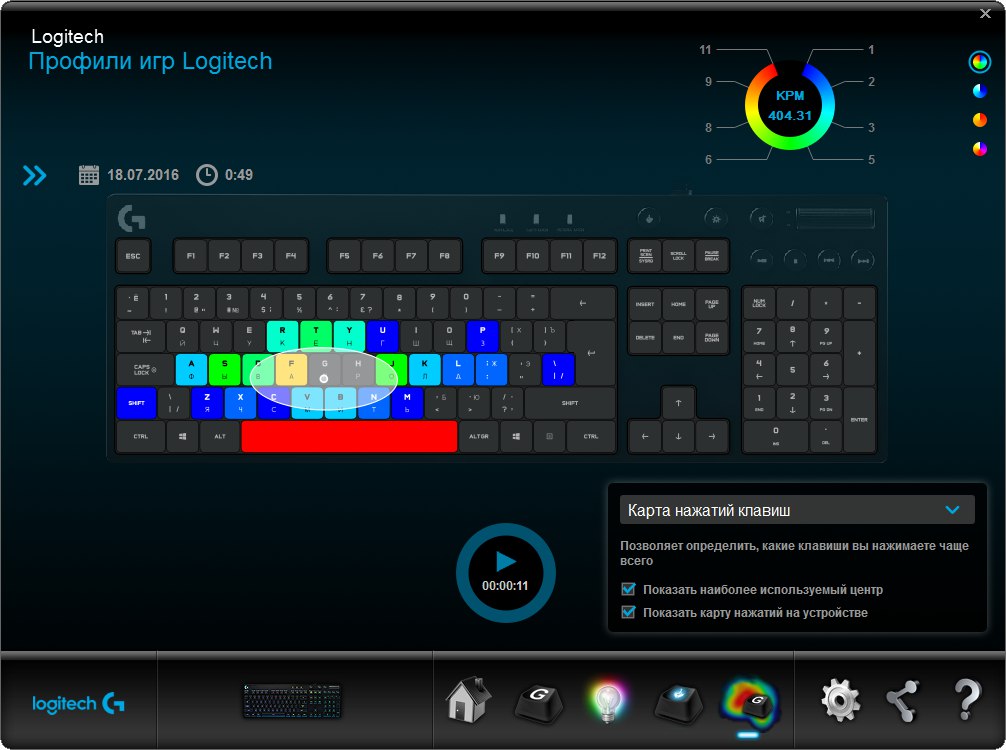
And the last - click card. Honestly, almost useless stuff. It is good when the keyboard always keeps full statistics. Here, for statistics, this mode has to be included. Why not always collect statistics? Even taking into account the fact that the activation of the collection of statistics can be hammered on the G-key, one has to make extra gestures. I would like to see a simpler solution.
Testing: taiping and sensations
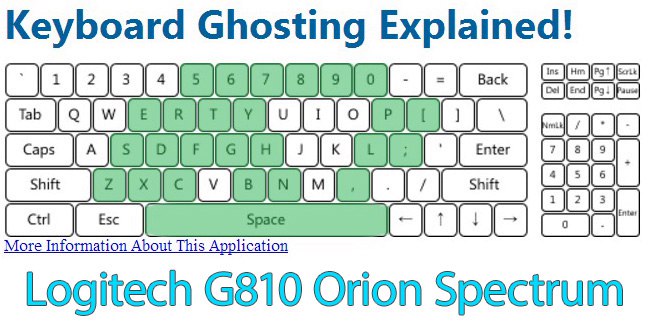
The keyboard supports simultaneous pressing of 26 keys when connected via USB - the keyboard has a good controller. It is a pity that there is no Full KRO, however, pressing all the keys at once is rarely carried out in practice.
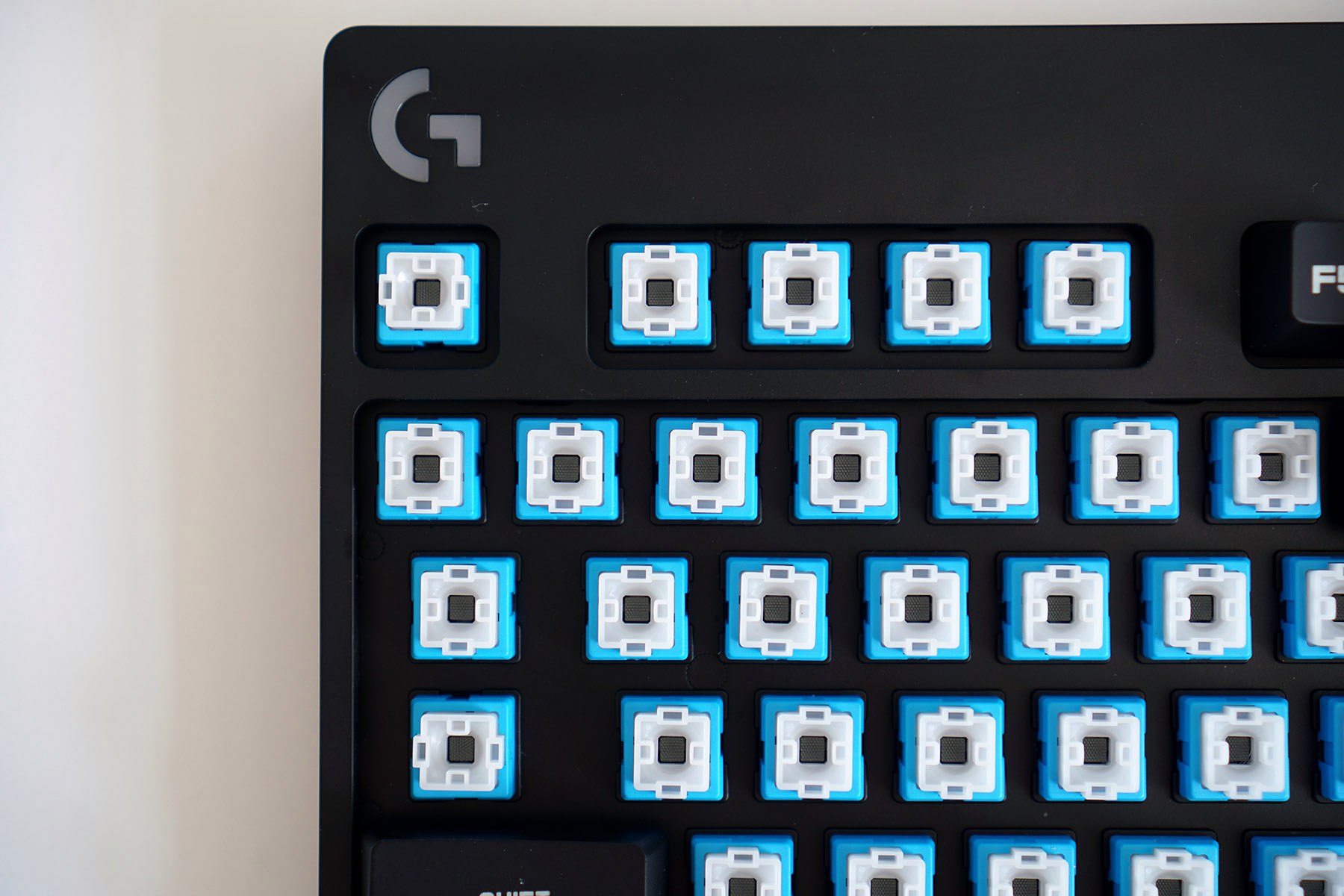
And the most important thing for which mechanical keyboards are generally loved is taiping. First of all, it immediately becomes noticeable that the keyboard is very quiet in the background of any other mechanics. Against this background, the keys with stabilizers violate the general peace and quiet. The same space is noticeably clicking each time you press it. On the role of a quiet keyboard G810, most likely, will not work. And it is because of the stabilizers on the big keys, which emit a metal bounce.
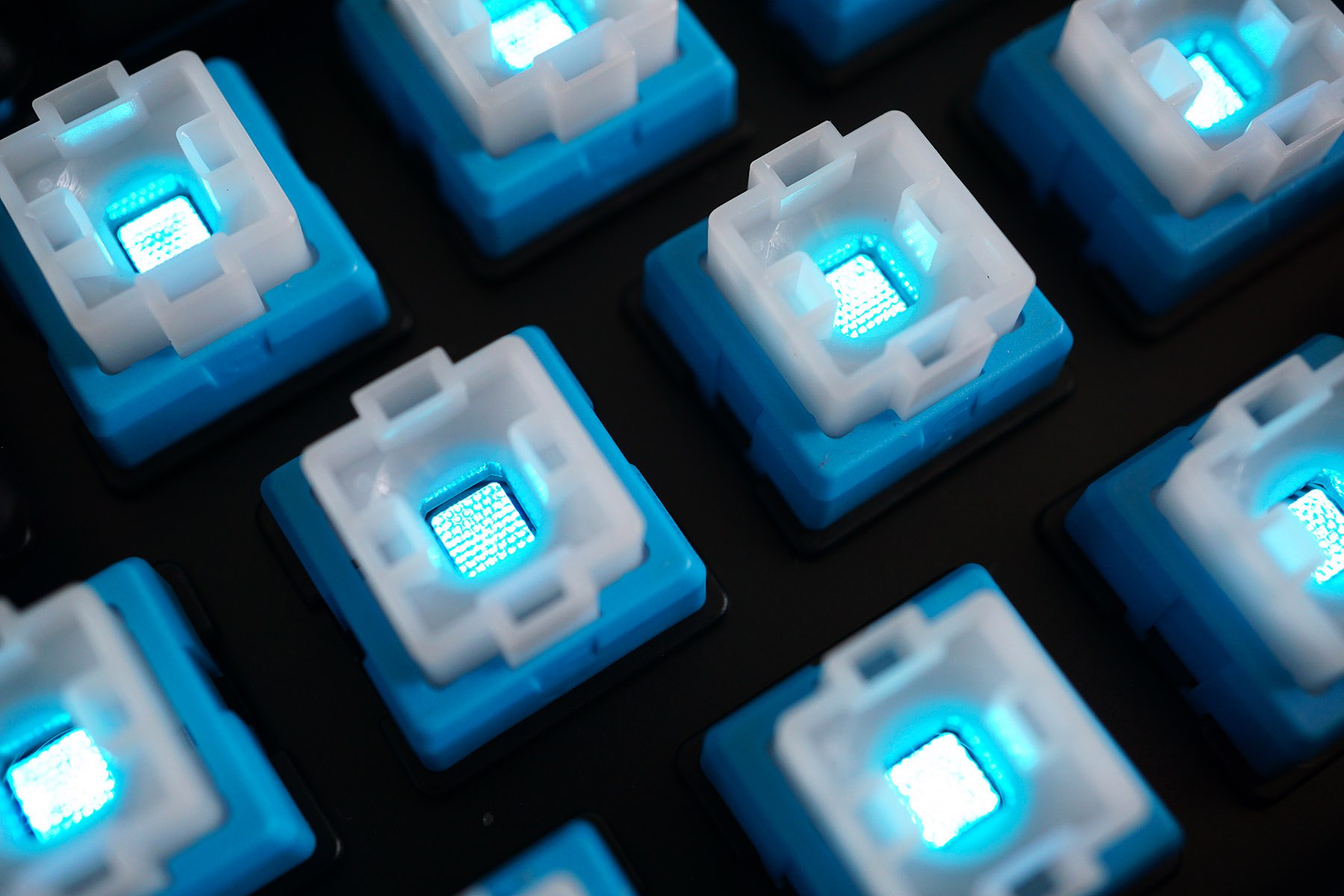
As for the rest. The presses are pleasant, soft, slightly muffled and almost silent, there is a slight rustling when you press the key. Striking the substrate while pressing the key to the end is also almost silent, imperceptible. Conventionally, tapping on Romer-G is slightly louder than tapping on a membrane keyboard, but it is much quieter than on Cherry and other switches. Though linear (MX Black / MX Red), though non-linear (MX Brown).More like the feeling that MX Brown was wearing rubber rings (called the O-Ring, which are designed to reduce noise and decrease key travel) and made the tapping more dull. I did not feel any sticking when pressing or returning the key, although this is found in some Cherry analogs.
But the keystroke is still strikingly different from membrane keyboards and from classic mechanical ones. The nature of the press is still closer to the membrane keyboards. From them, the keys got a soft move and silent operation of the switches themselves, but at the same time there is a mechanical move, a tactile barrier is clearly felt when the switch is triggered, and the return of the key to the place is felt - there is no such viscosity, "rubberiness" when pressed. So pressing is clearer than on membrane keyboards, but, let's say, less pronounced than on long-stroke mechanics. There is a “mechanical” move, but because of the shortened key travel (the overall travel of Romer-G is 3 mm), the switches are perceived as a “fast” version of mechanics - pressing faster, the tactile barrier is slightly more blurred, the stroke is shorter, but there is a purely mechanical character keystroke.
It is better to see once than to try to present the above.
Feels clean - I liked it. Loved it.I don’t really like membrane keyboards because of taiping, and therefore I prefer mechanics for a long time. And here I got a mechanical move, and a faster response to all my clicks. Yes, taiping is still unusual, because, even in spite of the tactile feedback, the keyboard gives quite different sensations, but these are new sensations, and you quickly get used to them.
The same strays in games to play on Romer-G are more pleasant than on Cherry MX Brown, but in such situations I still prefer linear switches. So the switches are well suited for games, but I liked it more for them to work with the text. The reduced space did not affect my pressing, but the double-decker enterter made itself felt: often I clicked a slash instead.
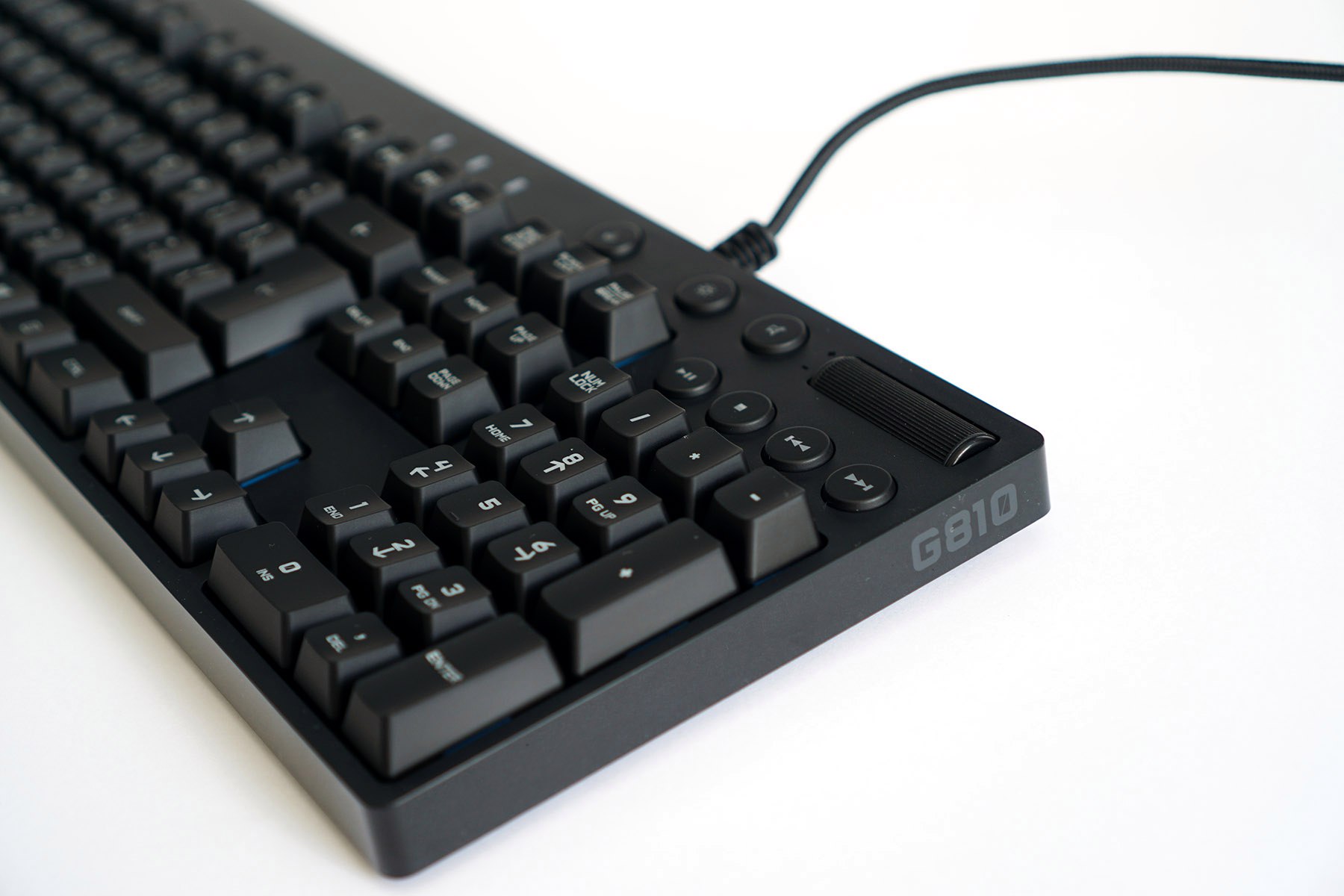
Additional keys are pressed with a clear click and almost no free play. The sound control wheel has an easy turn and has no cutoffs - a purely analog wheel for adjusting the sound volume by ear.
findings
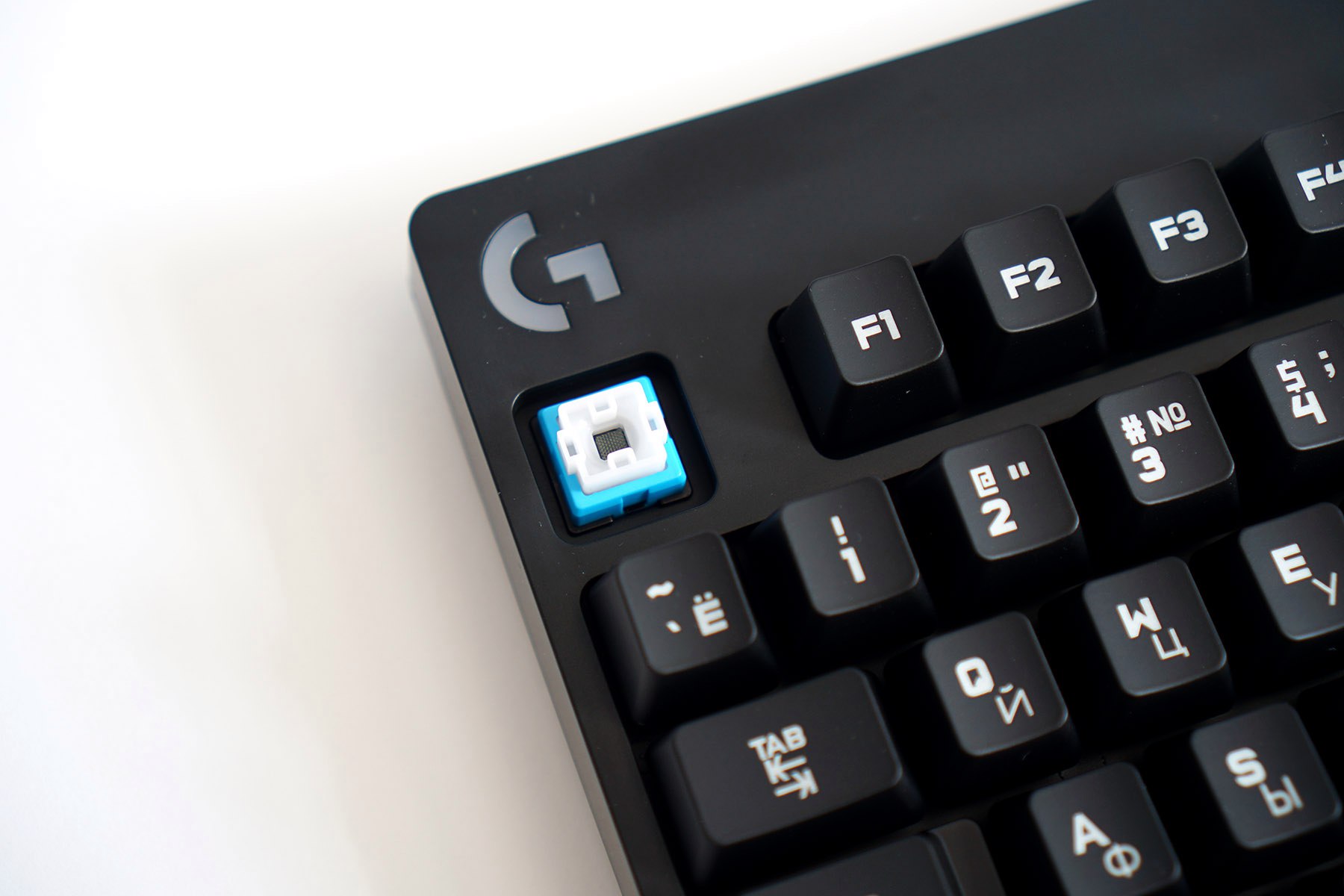
At the exit, the Logitech has turned out to some extent a unique keyboard with a concise appearance, a classic body and unusual, but cool switches. When communicating with the device, the Logitech thought of literally everything - about the body, and about ergonomics, and the location of the keys, and the switches, and ... but about everything! Only keycaps are worth something. I have not seen this anywhere. The keyboard software is simple and functional, but some limitations in it are clearly not pleased. Most of all, of course, was disappointed by the lack of internal memory and the lack of switching profiles on the fly, which is why to adjust the keyboard each time you have to go into the software. But this, to some extent, is not critical.
Separately, I would like to note the process of typing on a keyboard - these are completely different sensations that neither a typical membrane keyboard nor any other mechanical keyboard can offer. I just liked the printing process, and for me it is clearly nicer than typing on the same membrane. It’s hard to compare with conventional mechanics - it’s just a different feeling, but I can say that if you have never sat on a mechanical keyboard before, and you’re generally used to a membrane keyboard, but still want to get new sensations and just a new reliable keyboard - pay attention to Logitech G810. With tangible design differences, it will be much easier and more enjoyable to switch from a membrane keyboard to such mechanics, and you, like me, will most likely love the printing process.
So in general, the keyboard can produce a huge amount of advantages with a small and far less significant number of flaws, which you simply forget about in the process. This keyboard is easily able to compete with competitors in the face of other "classic" mechanics. The price of the keyboard in retail at the time of writing the review: about 10,000 - 11,000 rubles. It is an adequate price tag for such a board.
pros
- Ergonomics
- Appearance
- Materials
- Classic case
- Keycap performance
- Romer-G switches
- RGB backlight
- Resilience
- Cable
- Software
- Overall quality of performance
Minuses
- Glossy case trim
- Lack of equipment (puller)
- Lack of internal memory for storing settings
Special features
- Two-story enter
- Non-standard keycap mounting
- Cherry Stabilizers
- Fixed cable
- Keyboard software limitations
Source: https://habr.com/ru/post/396009/
All Articles